News
The future of technology and world class education hinges on the ability of universities to continue to provide a premium higher education experience. Their curricula need to be aligned closely to the demands of the world more than ever before.
 According to University World News, Zimbabwe has warned their universities that they must return to their initial STEM mandates thereby reverting to their cores. By producing STEM professionals the government believes they can help to create wealth in a country which has endured protracted and very difficult economic times. A large chunk of the country’s prosperity depends on how many STEM jobs are being filled.
According to University World News, Zimbabwe has warned their universities that they must return to their initial STEM mandates thereby reverting to their cores. By producing STEM professionals the government believes they can help to create wealth in a country which has endured protracted and very difficult economic times. A large chunk of the country’s prosperity depends on how many STEM jobs are being filled.
The Deputy Minister of Higher and Tertiary Education, Science and Technology of Zimbabwe, Honorable Dr Godfrey Gandawa was quoted by Chronicle, saying:
“We cannot continue to ignore the global trend; there is a need for serious curriculum reform. Students deserve a modern education right now. Instead of a 19th century style, students need modern competences, development of a growth mind-set and a strong character.”
Britain has addressed the need for more STEM professionals; according to the Telegraph, candidates best suited to employers’ demands have increased. In recent years the demand for STEM professionals versus the number of suitable candidates was a ratio of 2:1. The ratio is now 0.90.
Interestingly, the millennial generation: people in their 20s, and 30s are very interested in forming part of STEM industries, whereas the Baby Boomers (those nearing retirement age) are less keen on finding STEM jobs. These revelations came from online jobs classifieds giant, Indeed.
Teachers Wanted
There is a hurdle remaining when it comes to addressing the shortages of STEM professionals around the world. It involves the training and retaining of school teachers who teach STEM subjects ably and in the context of the demands of the real world.
The Scottish government has put together a plan that would offer bursaries to those wishing to be trained as teachers of STEM subjects. These bursaries would total £20,000 each.
 The country is hoping to find 100 bursary candidates a year, thereby budgeting £1 million per year.
The country is hoping to find 100 bursary candidates a year, thereby budgeting £1 million per year.
The Deputy First Minister of Scotland John Swinney said:
“STEM subjects are crucial, not just to the education of our children but the future of the economy. We need to recruit more teachers in these subjects. And to do that, we need to reach beyond recent graduates and attract people who have the appropriate subject degree but are working in business or industry.”
Whether or not the Scottish government’s plans will work, governments are all in agreement: innovative and relevant STEM education (with some stress on entrepreneurial endeavor) and STEM graduates are critical to the growing of the global economy.
Works Cited
Christie, Sophie. “Growing Interest in Science and Engineering Jobs Set to Tackle Britain's Skills Gap.” The Telegraph, Telegraph Media Group, 2017, www.telegraph.co.uk/business/2017/09/19/growing-interest-science-engineering-jobs-set-tackle-britains/.
Macnab, Scott. “Scots Workers to Be Offered £20,000 to Retrain as STEM Teachers.” Politics, The Scotsman, Aug. 2017, www.scotsman.com/news/politics/scots-workers-to-be-offered-20-000-to-retrain-as-stem-teachers-1-4581534.
“STEM: Foundation for a Progressive Future.” The Chronicle, www.chronicle.co.zw/stem-foundation-for-a-progressive-future/.
 Internships provide the opportunity for a prospective professional to gain the work experience needed in the industry they are aiming to work in. Internships enable students or workers to gain the work experience that is being sought after by employers. Adding ‘work experience’ to the curriculum vitae is an invaluable addition that sets a candidate apart from others who don’t have any, especially in engineering industries.
Internships provide the opportunity for a prospective professional to gain the work experience needed in the industry they are aiming to work in. Internships enable students or workers to gain the work experience that is being sought after by employers. Adding ‘work experience’ to the curriculum vitae is an invaluable addition that sets a candidate apart from others who don’t have any, especially in engineering industries.
Internships are particularly famous for being used to implement more equality within industries that lack gender neutrality. Some companies believe, for example, that internships specifically designed for women, will bring more females into STEM (Science, Technology, Engineering, Mathematics) workplaces. At other times internships are used to show prospective employees the ropes and give them a taste of an industry.
Internships are usually well run programs that do help individuals become professionals. There is a problem however: instead of a win-win, companies are using internships to their benefit without giving the interns much in return.
The unpaid intern fallacy
Some interns are being exploited. In their bid to gain that illusive experience they are taking on unpaid work. In the United Kingdom, for example, it is not uncommon to find qualified graduates working full time without pay. They often have to find alternative work, at night and at weekends, to make ends meet.
 The Institute for Social and Economic Research as the University of Essex have just published a report on the effect of post-graduate unpaid internships. Angus Holford, the lead author of the report, Access to and Returns from Unpaid Graduate Internships, writes:
The Institute for Social and Economic Research as the University of Essex have just published a report on the effect of post-graduate unpaid internships. Angus Holford, the lead author of the report, Access to and Returns from Unpaid Graduate Internships, writes:
“We show that, on average, former interns face a salary penalty of approximately £3500 per year compared with those who went straight into paid work, and £1500 compared with those who went into further study.”
A crackdown on unpaid internships has occurred in the United States. Companies are now being discouraged to advertise posts under the guise of unpaid internships that promise exposure and exposure alone. The government has taken it a step further and implemented the Fair Labor Standards Act which stipulates that an intern within a company must at least be paid minimum wage.
Students and workers are realizing that doing hard labor within companies, and not being compensated for it, is not worth their time. The rule of thumb, according to a number of engineers commenting on the matter in online forums, is never to take an unpaid engineering internship in the first place.
A system of temporary, on-the-job training positions, properly compensated, assists a student to further him/herself in an industry (and benefits the company too). Holford believes that this sort of contract is indeed useful:
“There is evidence that although workers on temporary contracts receive lower wages and job satisfaction, and less on-the-job training than those on permanent contracts, temporary contracts do act as a ‘stepping stone’ into permanent employment for university graduates.”
Rewriting study and work experience
Steve Mackay, Dean at the Engineering Institute of Technology (EIT), believes that where possible, study and work should be undergone simultaneously because practical work experience and theory-based knowledge are an excellent complement when acquired together. Steve recently outlined how the system of education and training at the EIT blends on-the-job training with part-time studying
EIT’s Bachelor of Science and Master degrees are contingent on students getting positions within a company, in an industry that will equip them with the relevant engineering skills. EIT offers school leavers and already working individuals a flexible online study option which includes a three year BSc degree followed by a two years Master degree. In Steve’s words:
“We’re hopeful that, for most of those five years you can be working, if not full time, then part-time. That’s a critical aspect today which I believe a lot of universities ignore. We need to make sure you all get jobs. Once you’ve completed your 3-year BSc with us, you can continue to study for the two years Master degree part-time, alongside full time work.”
Online learning is certainly making it more convenient for people to acquire professional development and/or a qualification. It also makes the process of learning more meaningful; theory gained from study can be implemented in the workplace and tested. Being able to contextualize the learning will inevitably enhance the experience.
It would be preferable for companies to do away with unpaid, post-graduate internships. Instead, graduates should be given a chance to prove their worth, whilst being properly compensated for their efforts. If they haven’t been able to work alongside their studies they will need the necessary mentoring to help build their capabilities on the job. And when required they can complete relevant, online courses of quality, to ensure they develop professionally.
Works Cited
"ABC - Australian Broadcasting Corporation." ABC - Australian Broadcasting Corporation. 27 Feb. 2013. Web. 31 July 2017.
Holford, Angus. "Access to and Returns from Unpaid Graduate Internships." By Angus Holford :: SSRN. 10 July 2017. Web. 31 July 2017.

Friday night (the 25th of August) a tropical storm hit Texas in the United States of America. 60cm of rain fell overnight (23 inches) with a total of 50 inches expected before the week was out. Whether or not Texas’ drainage system is able to deal with the volume of water that climate change is bringing will be a pertinent question once relief efforts have been fulfilled. Questions surrounding Houston’s water infrastructure are already being asked.
A New York Times opinionista has pointed to climate change as the leading cause for Hurricane Harvey’s wrath whilst accusations of America’s hand in contributing to global warming persist. Simultaneously many face practical considerations - what to do in the aftermath of an infrastructure-crippling hurricane.
The devastation caused by Hurricane Harvey will encourage engineers to lend their minds to climate science studies and funnel this knowledge into solutions for a world facing an increase in natural disasters, many of which involve flooding. The lack of engineering foresight, thus far, has been highlighted in neighboring state Louisiana.
No lessons learned
In New Orleans, Lousiana, critical water infrastructure (pumps and canals) were not prepared for heavy rainfall this hurricane season. This is despite the New Orleans’ levee failures in 2005, during Hurricane Katrina. Those levee shortfalls can be found in case studies comparing them to some of the largest engineering failures of all time - including Chernobyl. Furthermore, the studies pertaining to Katrina clearly highlighted the inadequacies of the civil engineering practices within the United States Army Corps of Engineers.
New Orleans experienced a spate of floods on August 5th of this year, with Louisiana’s governor declaring a state of emergency as a result of the flooding. According to the New Orleans Advocate, repairs and maintenance on pumping stations reduced their efficiency by a third!
To give a little clarity to the problem: the drainage system in New Orleans is designed to deal with one inch of rain in an hour, and a half an inch each hour after the first. With this in mind, and according to the Economist, four out of five turbines were not working at one of the state’s pump stations during the floods, and other pumps, in harder hit areas, were down for maintenance. Elsewhere, staff shortages led to inefficiencies so pumps were not switched on in a timely manner.
The citizens in flood-hit areas of New Orleans have accused the sewerage and water board, (amidst other allegations of incompetence) of uncleaned/cleared catch basins which prevented water from moving to the drainage systems. This latest event has led to a political crisis in New Orleans. Officials, however, have said that old and poorly maintained infrastructure is an America-wide problem.
Thankfully New Orleans seems to have escaped the worst of Hurricane Harvey, avoiding the full brunt of the catastrophe 12 years after Hurricane Katrina.
Texas

The rising waters in Houston have resulted in a double-explosion at a chemical plant and, at the time of publishing, the hurricane has led to the deaths of 50 people.
The chemical plant belonged to Arkema Group, one of the world’s largest chemical companies. The coolant systems and power generators were rendered useless due to the floodwaters, and as a result the Arkema Group warned that an explosion was soon to follow. The plant exploded sending a large black plume of smoke into the air and forced police to evacuate an area of up to 1.5 miles. The Environmental Protection Agency (EPA) said that no toxic materials were reported to have been released but will continue to monitor the situation as more explosions are possible.
In Beaumont, Texas, flooding has caused the city’s water pumps to fail, causing 118,000 people to be without any running water. Hospitals have had to evacuate their patients and transfer them elsewhere due to the lack of water.
The Atlantic reports that the Association of State Floodplain Managers in Houston has tried to get funding for flood control, but in vain. Without engineering expertise in storm water management technologies it is unsurprising that an event such as Hurricane Harvey has wreaked such havoc.
City planning has also copped some criticism. An excerpt from the Atlantic’s article points to the fact that Houston and New Orleans’ cities are in flood-prone areas:
“The hardest part of managing urban flooding is reconciling it with Americans’ insistence that they can and should be able to live, work, and play anywhere. Waterborne transit was a key driver of urban development, and it’s inevitable that cities have grown where flooding is prevalent.”
And it seems that Houston’s everyday citizens knew that a hurricane would inevitably cause a flood.
People outside of HOUSTON believe this is a ONETIME thing but this HAPPENS every 2 MONTHS or SO .. BAD ENGINEERING & FLOOD CONTROL pic.twitter.com/oRaX8x7IWg
— Aristotle Onassis (@OnassisHa36) August 28, 2017
This is gonna be fun... But we have to appreciate the City of #Houston Public Works and Engineering team. Or else this would be much worse. pic.twitter.com/YKow0yrKxy
— TheGreatNike (@XboxNike) August 27, 2017
Works Cited
Bogost, Ian. "Houston's Flood Is a Design Problem." The Atlantic. Atlantic Media Company, 28 Aug. 2017. Web. 31 Aug. 2017.
Leonhardt, David. "Harvey, the Storm That Humans Helped Cause." The New York Times. The New York Times, 29 Aug. 2017. Web. 31 Aug. 2017.
Pipelines. Can’t live with them, can’t live without them.
 It is rumored that approximately three years ago a swamp kauri mining operation led to the damage of the Ruakaka-Auckland Pipeline (RAP) in New Zealand.
It is rumored that approximately three years ago a swamp kauri mining operation led to the damage of the Ruakaka-Auckland Pipeline (RAP) in New Zealand.
Swamp kauri has 50,000 year old trees that have been perfectly preserved under swamp peat. The extraction of this wood is a tedious operation. It is believed that a digger struck the RAP.
The pipeline has failed; it began leaking and it is alleged that there was increased damage from fuel transportation engineers. The RAP runs from Marsden to Wiri in New Zealand. The single pipe delivers diesel, both premium and regular, and jet fuel. It is believed 40% of New Zealand’s fuel travels through the pipeline.
A New Zealand fuel shortage resulted. The damaged pipeline delivers jet fuel to Auckland Airport - New Zealand’s premier airport - and 80,000 litres of jet fuel had leaked into the soil before the leak was discovered.
New Zealand’s Prime Minister Bill English dusted off any ‘crisis-talk’. When speaking to Sky News, English said:
“I wouldn’t use the word crisis, what’s happened here is no threat to cars and trucks in Auckland. A bit of minor inconvenience, 60 to 70 percent of scheduled flights are operating and this problem should be dealt with by early next week.”
Flight crisis
The reality is that flights have been cancelled, with thousands of passengers affected by the fuel shortage.
And rations were put in place – many planes have departed Auckland with 30 percent of their normal fuel levels. Tankers stepped in to deliver fuel to Auckland Airport, changing their normal transport routes, being forced to cart fuel from Marsden Port to Auckland Airport.
Qantas Airlines stepped up to the plate offering to fly a 747 from Sydney to Auckland to transport 50,000 kilograms of fuel to supply Jetstar and Qantas aircraft in New Zealand. A Navy ship named the Endeavour was also appointed to assist with the fuel shortages crisis.
According to the Guardian, traffic lights were reconfigured in Auckland to ensure that fuel trucks were given right of way, ensuring that fuel arrived at its designated destinations more quickly.
Questions asked
As with any engineering emergency, the questions pertaining to whether or not a disaster could have been avoided are asked. In 2012, a report by New Zealand’s Ministry of Business, Innovation and Employment, outlined contingency plans for damage to the pipeline.
Air New Zealand allegedly maintained the contingency plans for a disrupted aviation fuel scenario. They realized it would cause major operational issues for the airline and so asked that the government do something about it.

Source: Refining NZ
Refining New Zealand has been questioned about maintenance on the pipeline after the swamp kauri miners ostensibly scraped the pipeline two to three years ago. They responded that the pipe was indeed checked in 2014 and found to be in working order. The assumption is that when the diggers mined for swamp kauri one of the trees impacted the line as it was being pulled out of the ground. The trees are said to have been some of the biggest that farmers had ever seen.
The pipeline disaster came before an election in New Zealand and highlighted the infrastructural problems the country has been facing. Opposition Labour leader Jacinda Ardern blasted the ruling National Party of New Zealand saying:
“One pipeline and one digger and New Zealand grinds to a halt.”
The cause of the pipeline’s damage is still being investigated, but highlights a disturbing trend of damaged pipelines, the resultant cost to an economy and their considerable environmental impact.
Works Cited
NZ Herald By: Simon Collins, David Fisher: . "Airport Fuel Crisis: Kauri Log Digger Damaged Oil Pipeline." NZ Herald. Web. 20 Sept. 2017.
Roy, Eleanor Ainge. "New Zealand Jet Fuel 'debacle' Disrupts Election Campaign and Chokes off Exports." The Guardian. Guardian News and Media, 19 Sept. 2017. Web. 20 Sept. 2017.
"Swamp Kauri Mining at Fuel Site Was Years Ago - Neighbours." Radio New Zealand. 19 Sept. 2017. Web. 20 Sept. 2017.

The youngest future engineer EIT encountered at the expo was a boy of fourteen who told us that he had an affinity for Mechanical Engineering. The most sought after qualifications were Electric Engineering, Mechanical Engineering, and Civil and Structural Engineering.
A handful of students expressed their desires to build car manufacturing companies, actively seeking programs that would provide automobile engineering training.
In September of 2016, a fire broke out at the Central Aguirre Power Plant rendering electricity transmission lines useless. 1.5 million people were plunged into darkness. The blackout forced the government to declare a state of emergency. The Puerto Rican government was embroiled in a $9 billion debt crisis in 2016. New figures suggest the debt had totaled $70 billion.
Governor Alejandro Garcia Padilla was quoted saying: “This is a very serious event. The system is not designed to withstand a failure of this magnitude.”

A year later, Puerto Rico has become a victim of the tumultuous hurricane season. The territory was hit by Hurricane Maria – crippling the nation and knocking out critical infrastructure. 3.4 million citizens were left without drinkable water and no access to electricity after the hurricane swept over the land.
Once again, the territory’s fragile power grid failed to remain functional in the wake of the devastating hurricane. At least 16 people had died as a result of the storm as well.
According to CNBC, economists within the country are reporting that, thanks to the hurricane, Puerto Rico’s economic recovery has been set back by 10 years.
But how could the philanthropy of engineers assist the people of Puerto Rico? Well, with an electricity grid mostly useless, the engineering invention of lithium-ion batteries could have been of much help.
Power
Elon Musk took to Twitter to respond to a question pertaining to how useful his Tesla PowerWall house-powering - and more infrastructural PowerPack - batteries would have been, in response to Puerto Rico’s need for electricity after the hurricane. He said:
“The Tesla Team has done this for many smaller islands around the world, but there is no scalability limit, so it can be for Puerto Rico too. Such a decision would be in the hands of the PR govt, PUC, any commercial stakeholders, and most importantly, the people of PR.”
The latest governor of Puerto Rico, Governor Ricardo Rossello responded to Musk with a, “let’s talk.” Whether the two men have spoken is still not clear, however, Musk has intrigued many with his assertions that Puerto Rico could be powered by 100% renewable energy.
Nonetheless, the US Army Corps of Engineers jumped in to help Puerto Rico rebuild their infrastructure. They are trying to restore the power grid, using up to 270 generators. These would be used to power “life-sustaining facilities” first.
Internet and cellular
Alphabet, the company that owns Google, announced that they were to “help provide emergency cellular service in Puerto Rico”. They would do this by releasing and hovering an internet hotspot over areas that are without cellular service in Puerto Rico.

The hotspot is placed within a balloon and hovered over the area in need. The balloons used by Alphabet were conceptualized back in 2013 in a project named Project Loon.
Having access to a LTE network will ensure that vital communication needed to continue the rebuilding of Puerto Rico commences. Alphabet had to get a special license from the FCC to conduct the emergency cellular network. Once fully licensed and cleared with both the FCC and local providers, Alphabet intend to float 30 balloons over the territory to supply much needed coverage to those in need.
To see how Alphabet does this, look at their video below:
Works Cited
Imbert, Fred. “Puerto Rico's Economic Recovery May Now Take More than a Decade.” CNBC, CNBC, Sept. 2017, www.cnbc.com/2017/10/09/puerto-rico-economic-recovery-may-now-take-more-than-10-years.html.
Jon Brodkin. Oct 9, 2017 4:03 pm UTC. “Alphabet’s Internet Balloons Will Try to Restore Cell Service in Puerto Rico.” Ars Technica, Sept. 2017, arstechnica.com/information-technology/2017/10/alphabets-internet-balloons-will-try-to-restore-cell-service-in-puerto-rico/.
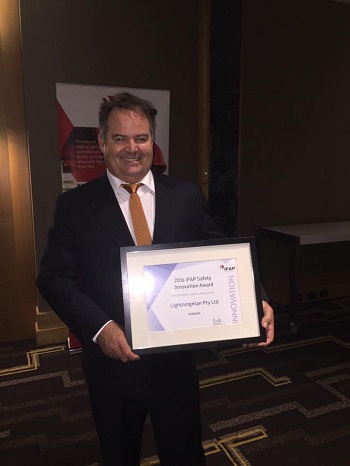 Grant Kirkby is a graduate from the Engineering Institute of Technology. He studied Electrical Engineering through EIT, starting in 2009 and graduating in 2011.
Grant Kirkby is a graduate from the Engineering Institute of Technology. He studied Electrical Engineering through EIT, starting in 2009 and graduating in 2011.
He is now the director of a company that grapples with the most dangerous, most unpredictable forms of electrical current: lightning.
Lightning and High Voltage (HV) electrical discharge events are considered common in engineering industries where outside activities are performed. Those industries include:
- Tented exploration camps
- Exploration drilling
- Pipeline maintenance
- Traffic signal maintenance
- Electrical linseman
- Environmental scientists
- Geologists and surveyors
- Fencing contractors
- Outdoor workers
Kirkby works in Lightning Risk Mitigation, coupled with Occupational Health and Safety. It involves finding a greater understanding and awareness of personal lightning safety risk.
Kirkby owns his own company named ‘Lightningman Pty Ltd’, a company that trades in Lightning and Surge Technologies. They are a specialist distributing wholesaler of Lightning Risk Mitigation products and technologies for higher risk industries.
Since completing his studies, Grant was appointed as the Exclusive Distributor for various Lightning Protection and safety related manufacturers. Kirkby knew the industry lacked a bona fide solution to the risk lightning posed to higher risk operations. He said:
“Since I have completed my studies, I have collaborated with a leading Australian Lightning Researcher to gain a better understanding of lightning risk mechanisms, and the research and development of innovative Lightning Safety controls.”
Through the collaboration, they filed a patent for what Kirkby calls the world’s first portable ‘Earth Potential Rise (EPR) Safety Mat’, for use by higher risk workgroups.
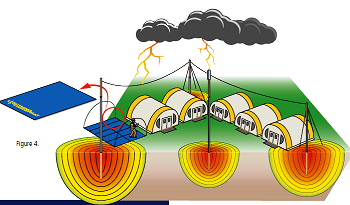
Image: Typical application - Remote Exploration Camp
Operations involving high risk activities in an outdoor setting can utilize Kirkby’s LightningMat to lower the risk of being struck by lightning - the mat lowers the statistical risk of up to 50 to 70 percent.
The invention won the 2016 Industrial Foundation for Accident Prevention Safety Innovation Award. The mat is also cost effective so that industries can make an invaluable, reasonable investment into securing their operations from the weather.
When asked about how his life has changed since he obtained his qualification through the Engineering Institute of Technology, he replied:
“I have a great sense of personal achievement that has since developed into a strong desire to innovate, to make a difference, and to have been seen to have made a difference, personally, professionally, and commercially.”
Kirkby says he is no longer phased by “seemingly insurmountable problems” and tackles engineering conundrums head-on. By no means, however, is Kirkby slowing down, or admitting that there isn’t more to learn about the industry he is so fascinated by. No, Kirkby intends to keep on learning and innovating. He said:
“I am very interested in further Research and Development activities, specifically in product/process development in the area of Lightning Risk Mitigation in higher risk environments. To develop new ideas/concepts that will be the world’s best practice and the technical benchmark that shapes the way higher risk activities deal with Lightning Safety in the workplace.”
Kirkby’s LightningMat is now being exported to four continents ; Africa, Australia, South East Asia and South America.
Marc Edwards is a Professor of Civil and Environmental Engineering at the College of Engineering at Virginia Tech. He is not only an engineer he is also a whistleblower. Along with citizen scientists, and concerned residents, Edwards exposed the Flint Water Crisis which began in 2014 and persists today.
Edwards blew the whistle on the ill practices of entities working to intentionally cut corners in the water infrastructure of Flint, Michigan, and the United States as a whole.

Source: Wikipedia
A keen studier of America’s aging infrastructure, Edwards pulled the veil back on ‘scientific misconduct’ of the Environmental Protection Agency and the Centers for Disease Control and Prevention dating as far back as 2001. He put together a report named: ‘A Public Health Tragedy: How Flawed C.D.C Data and Faulty Assumptions Endangered Children’s Health in the Nation’s Capital.”
In Flint, he found that the city had changed from a system where they initially got treated water from Detroit’s Water & Sewerage Department, to a system where they started consuming water from their own polluted river.
The situation was made more harmful due to the fact that the water was being distributed through old lead pipes. The water had purportedly transgressed the Safe Drinking Water Act four times. Flint’s treatment plant purportedly failed to use vital chemical treatments to prevent the corrosion of pipes - pipes that when corroded released lead into the water supply.
Edwards testified to the American Congress, accusing the Environmental Protection Agency of willful blindness to the pleas of inhabitants involved in the man made disaster. He accused them of being unrepentant, and unable to learn from their mistakes. Through his studies, he showed that the EPA’s malfeasance stemmed from 2001 all the way through to 2016.

“I guess being a government agency means you never have to say sorry,” Edwards said in his testimony. He believed that the Flint Water Crisis showed that there could be a dark side to science, engineering and academia.
Edwards explains that the installation of lead pipes into U.S. water infrastructure was a disaster and a tragedy. From 2000 to 2004 miscarriage and fetal death rates spiked due to mothers drinking water fed from lead pipes.
Even the Roman engineers as far back as the 1st Century BC knew not to use lead and water in the same system.
In February of 2016, in Flint, Michigan, it was revealed that the lead levels were 900 times higher than limits set by the Environmental Protection Agency.
Moral authority
Engineers should strive to operate in an ethical manner, thereby becoming the moral authority in their particular field of practice. Moral authority is defined as the quality or characteristic of a person, institution, or written work that is respected for having good character or knowledge, especially as a source of guidance or an exemplar of proper conduct.
In a bid to eliminate the chance of ethical or moral mistakes in the field of engineering societies were established in the 19th Century. The intention was to establish professional standards and ethical principles for engineers and their profession.
The American Society of Civil Engineers, for example, sets out the following ethical rule-of-thumb:
“Engineers shall hold paramount the safety, health and welfare of the public and shall strive to comply with the principles of sustainable development in the performance of their professional duties. “
The Institution of Civil Engineers’ creed reads:
“Members of the ICE should always be aware of their overriding responsibility to the public good. A member’s obligation to the client can never override this, and members of the ICE should not enter undertakings which compromise this responsibility. The ‘public good’ encompasses care and respect for the environment, and for humanity’s cultural, historical and archaeological heritage, as well as the primary responsibility members have to protect the health and wellbeing of present and future generations.”
Despite these strictures, around the world, from the governmental to the training levels of engineering, unethical practices persist and often snowball into tragic events.
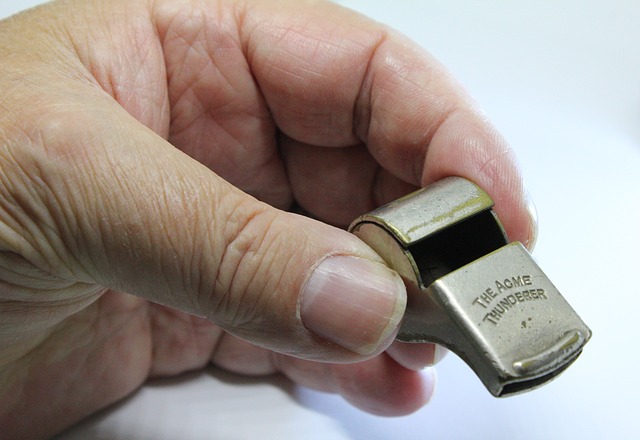
When an engineer notices abuses within the profession, those that transgress the ethical and moral principles that engineers should adhere to, blowing the whistle may be the answer. It does, however, take an enormous amount of courage and a considerable depth of knowledge. Marc Edwards had both and is to be commended.
Works Cited
“Marc Edwards | The Flint and Washington D.C. Drinking Water Lead Crises.” YouTube, Apr. 2016, youtu.be/dEgZpM6j6cc.
VirginiaTech. “Virginia Tech's Marc Edwards Testifies about the EPA's Role in Flint, Michigan.” YouTube, YouTube, 2016, www.youtube.com/watch?v=3VG57IWQfZ4&t=196s.
Are you studying with the Engineering Institute of Technology (EIT) online for a Bachelors Degree or Masters of Industrial Automation? A Visitor Visa or a Working Holiday Visa would allow you to spend 3 – 4 months studying on-campus with the EIT in Perth, Western Australia.
For 3 or 4 months of your degree (depending on your eligibility for a visa), join the EIT team on-campus in Perth, Western Australia. Outside of your study time you can explore the stunning and unique parts of Western Australia and experience the lifestyle.*
EIT’s beautiful campus grounds are located in the heart of East Perth, minutes away from the Central Business District and within easy access to free public transport. Tourist attractions, shopping centres and the famous WACA cricket grounds are all close by.
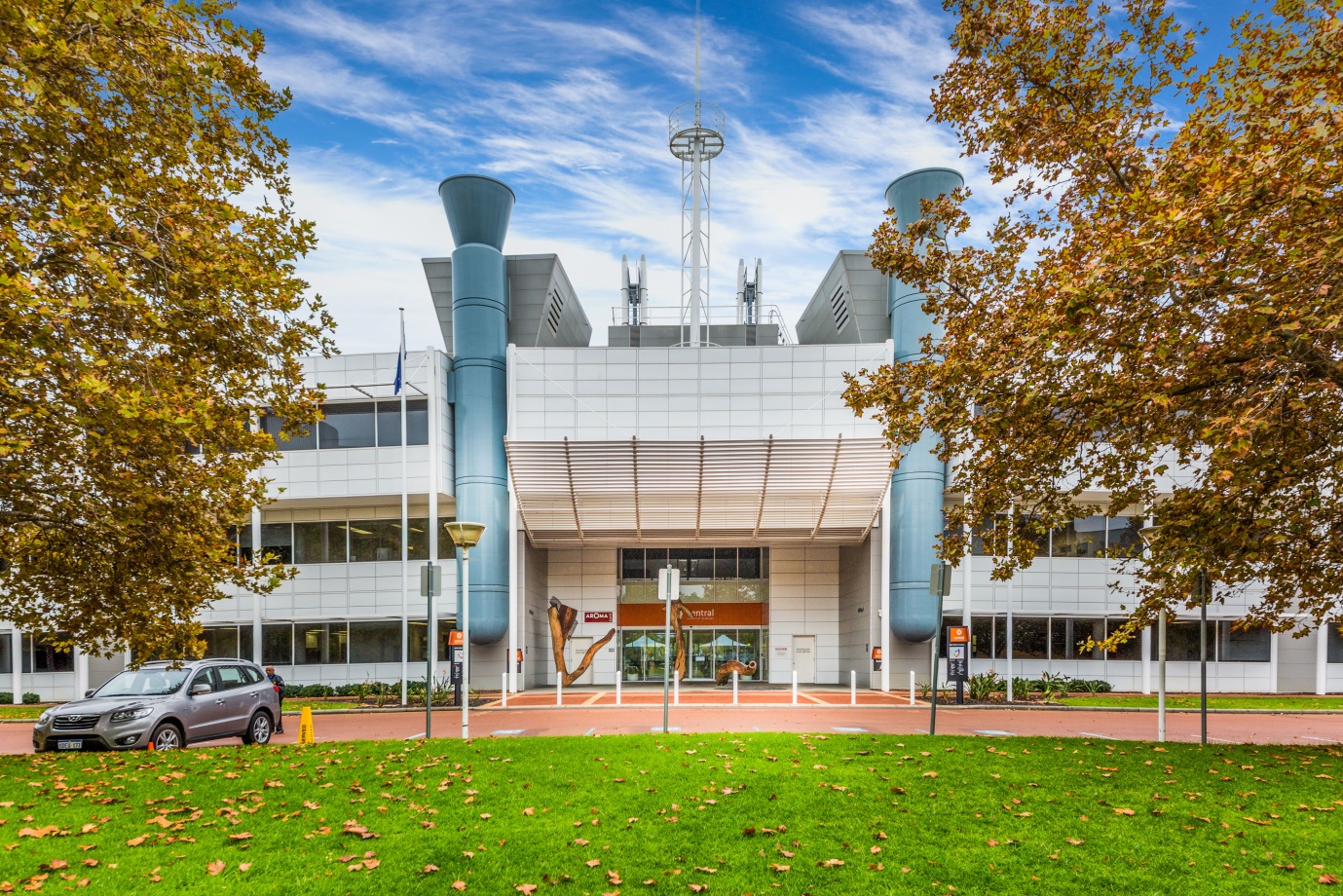
Western Australia covers the western third of Australia. Its population is concentrated in its fertile southwest corner, home to the famous Margaret River wine region and the riverside capital, Perth. The Kimberley region is located in the north and is home to ancient Aboriginal rock art, the Bungle Bungle sandstone domes and Broome’s Cable Beach, camels and pearling industry.
For further information on this exciting opportunity please email us.
*Please note: studying on-campus in Australia for a period with EIT would entirely depend on your eligibility for a visa and the current unit delivery schedule. Please visit https://www.border.gov.au/Trav/Stud for more information.
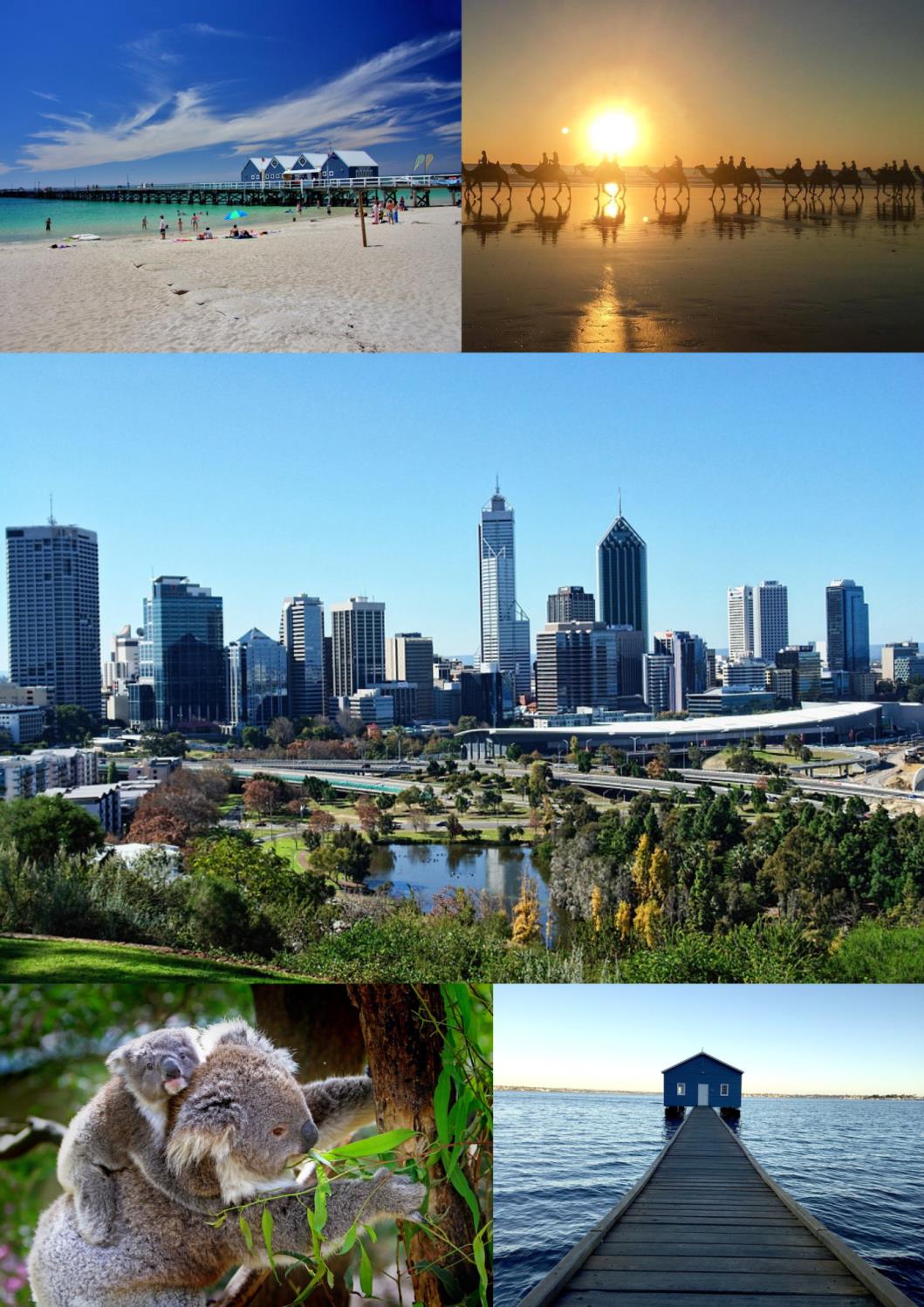
Over the last five years renewable energy technologies have seen more investment than ever before. Many governments have made plans to phase out energy generating technologies that harm the planet, hoping to achieve a world powered by fully renewable energy generating technologies by 2030. Solar and wind are two industries that have particularly skyrocketed - in both research and implementation. An idea that hasn’t seen an equal amount of attention is the harnessing of one of Mother Nature’s most powerful forces; the ocean. Harvesting the energy of waves and ocean currents is, however, not a new concept; engineers have been hypothesizing its feasibility for quite some time.
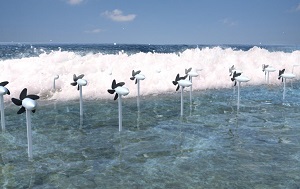 Research into the ocean’s energy is being conducted by Okinawa Institute of Science and Technology (OIST). Their graduate engineers and scientists have developed wave energy power turbines.
Research into the ocean’s energy is being conducted by Okinawa Institute of Science and Technology (OIST). Their graduate engineers and scientists have developed wave energy power turbines.
A project appropriately titled ‘Sea Horse’ is aiming to embed turbines in the seabed with mooring cables. The turbines will be aligned to capture wave energy and the ocean current that flows between Taiwan and southern Japan. The group’s first test of the turbines was purportedly successful - they are now seeking an industrial partner to turn the experiment into an electricity-generating commercial reality.
Professor Tsumoru Shintake at OIST and the Quantum Wave Microscopy Unit says that the turbines could even work alongside or in front of the current tetrapods on Japanese coastlines. Tetrapods are concrete structures engineered to weaken the strength of oncoming waves; common in coastal engineering. Shintake believes new ‘intelligent’ tetrapods fitted with wave energy turbines could generate renewable energy. He says:
“Particularly in Japan, if you go around the beach you’ll find many tetrapods. Surprisingly, 30% of the seashore in mainland Japan is covered with tetrapods and wave breakers.”
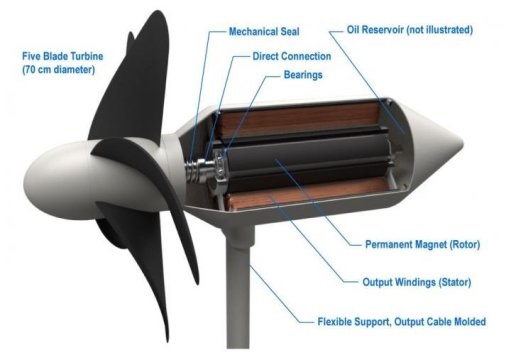
Shintake claims that the turbines, if installed in only 1% of seashores in mainland Japan would generate up to 10 gigawatts of energy. For context, the collective solar and wind power output in the United States at the end of 2015 was 100 gigawatts. A single nuclear power plant produces 1.21 gigawatts of power - meaning wave power could produce 10 times the amount of power a nuclear power plant could.
The turbines are designed with flexibility in mind. A turbine’s fins and its support stem are able to bend when a wave crashes into it and is able to handle tough conditions (rough seas, including extreme weather conditions).
According to the Bureau of Ocean Energy Management, the areas where ocean wave energy technology would be most effectively utilized include coasts of ‘Scotland, northern Canada, southern Africa, Australia, and the northwestern coast of the United States, particularly Alaska.’

Source: Professor Tsumoru Shintake
Works Cited
“Ocean Wave Energy.” Bureau of Ocean Energy Management, www.boem.gov/Ocean-Wave-Energy/.
“A Sustainable Future Powered by Sea.” Okinawa Institute of Science and Technology Graduate University OIST, 2017, www.oist.jp/news-center/news/2017/9/20/sustainable-future-powered-sea.
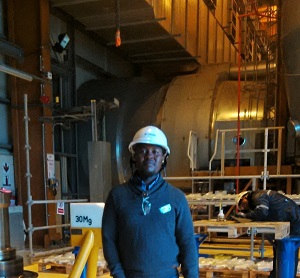 Ntobeko Dan Xulu
Ntobeko Dan Xulu
Ntobeko Dan Xulu is an Engineering Institute of Technology (EIT) graduate and grateful to his employer for the bursary they gave him to study with EIT. He has successfully obtained an Advanced Diploma in Plant Engineering.
He has been working at South Africa’s electricity utility, Eskom, for the last nine and a half years. When he joined the utility in 2008, he spent his time working as a project planner/ planning engineer, eventually becoming a technical project manager. Xulu gained a lot of experience in the field of project management, contract management and turbine maintenance.
He has since progressed to the role of Acting Senior Project Manager in 2017, working parallel also as Project Planning Head of Department in Eskom. Xulu was recently awarded with a Project Manager of the Year CEO Award in 2016.
Online education
Ntobeko was surprised to stumble upon the Engineering Institute of Technology as a prospective education and training institution. He was rightfully critical in the beginning, but found out that online study was perfect for him in the end. He says:
“The idea was less appealing until I downloaded a brochure and I looked at the content in detail. I then enrolled for the Professional Certificate in Mechanical Engineering in 2012. I was comparing it to our South African content of N1-N4 courses. I could not believe what I learned in the first 3 months - it almost covered the entire 2-year South African syllabus.”
He is now hoping to inspire others and share the expertise he has accumulated in a career that is maturing with every passing day. Through utilizing EIT’s ebooks, available in the online library, and the course material, he has been able to continue growing his skillset whilst being on-the-job. He says:
“To be successful in this rare and unique type of education, one has to commit for the duration of the program, and spend at least two hours a day. It is fun because every day you learn new things.”
Student becomes teacher
The course material complemented Xulu’s studies in many ways; he went on to develop a training program for trainees being introduced into the industry via the utility. He also developed turbine and generator fundamentals for a project planners program.
“Most importantly, I learned, formally, how to conduct myself as an engineering graduate and leader.”
He hopes to pursue his Bachelor of Science in Mechanical Engineering next, reveling in the fact that he has credit from his previously earned Advanced Diploma - a testament to the structure of continuity within EIT, says Xulu.
Motivation
Motivation was the key for Ntobeko. His desire for knowledge was incredibly strong. He recalls what kept him so motivated to finish his qualification:
“Knowledge, knowledge, and desire for knowledge. I had so much desire to know. I love turbines, I never lost energy. I was always looking forward to the next set of books from the Learning Support Officer - the EIT books make reading interesting, you start to flow like you’re reading a novel, and you don’t get bored.”
At EIT, we are very pleased to receive the following feedback from one of our MIA01 Master Degree Graduates, Kannan Periyaiya.
Kannan says:
"I am very proud to have been one of the pioneers and batch of the first successful students to complete this course. This course was a huge challenge for me personally. As mentioned before that without the technical writing course skills and completion of MIA01 it would not have been possible. I was almost about to give up until Natalie Holland and Robert Holm provided me the relentless support to complete the course.
In summary, my time with EIT has enriched my life in many ways. It has provided me with the necessary tools to enhance my technical skills even further, taught me valuable information about this diverse world and people and concepts in general and eventually will allow me to hopefully become even more successful in my working life once I’ve finally graduated with my master degree."
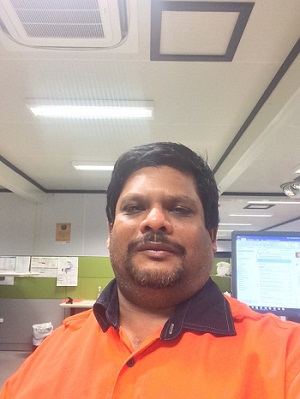
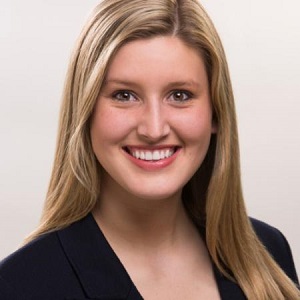
Paige Kassalen is a 24 year old electrical engineering graduate from Pittsburgh, Pennsylvania, who is making waves in the engineering industry. By the age of 22, Kassalen had been involved in a world-first solar plane project, and by 23, had been awarded a spot on the prestigious Forbes 30 Under 30 list.
The Engineering Institute of Technology sat down with her to marvel at her achievements, find out what drives her, and to talk about how engineering industries can do more to recruit females into Science Technology Engineering and Mathematics (STEM) fields. EIT is keen to encourage many more females in its practical online engineering bachelor and master degrees.
After graduating through Virginia Polytechnic Institute and State University, Paige was equipped with the problem solving skills necessary for starting the rest of her career. She believes that engineers are born with the ‘knack’ for problem solving. She says:
“The best engineers are the kind of people that have a passion for building something or creating something and have that drive for problem solving. That’s something that I had growing up; I loved to figure out how things work. I was happy that there was a field like engineering that gave me those tools that I needed to solve those real world problems.”
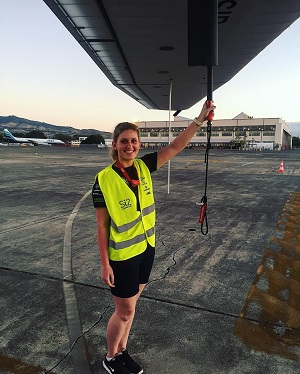
Intern to high-flier
Kassalen became a Process Control Technology intern at a company that supplies high-tech polymers named Covestro. From there, she became a commercial trainee, rotating throughout Covestro’s three business units.As an electrical engineer at a material sciences company it was an interesting change of pace, she said.
She was then asked to represent the company as a ground crew member for Solar Impulse, which was an initiative that aimed to fly a plane around the world powered only by the sun. Covestro was an official partner of Solar Impulse, providing both materials and technical expertise to the project.
“On the ground crew I had to be ready for any task that came up. You have to be ready for everything when you’re working on an impossible project.”
Being part of the ground crew responsible for keeping a solar plane on track, on a trip around the globe, was no easy feat. Kassalen tells of the intricacies involved with catching the plane by the wings when the plane landed. The solar plane’s wingspan was almost the size of a Boeing 747s wingspan, and the airplane had tandem wheels. Paige and the other members of the ground crew had to run alongside the airplane, and had to ensure the plane remained stable.

Her electrical engineering prowess was fully realized when she was one of four engineers who presided over the power systems of the mobile hangar where the plane was stored.
Within areas of countries without hangars big enough for the plane, the plane would have to be stored in an igloo-shaped mobile hangar. Setting up the mobile hangar took 10 hours, and 14 to 17 members to inflate.
Paige, and three other engineers, had to regulate the power systems that powered the fans that inflated the hangar.
To stay abreast of being thrown in the deep end of a challenging engineering project, Paige rolled with the punches and continued learning as the project charged ahead. She said:
“I spent a lot of nights on YouTube, making sure that I studied a lot of power systems or generators, just making sure that I wasn’t going to let me being a new engineer hold me back from being involved in the project.”
Women in STEM
Paige is a shining example of how gender inclusivity in the engineering world can lead to great things. She co-chairs with the Pittsburgh chapter of the Institute of Electrical and Electronics Engineers’ Women in Engineering affinity group. Whether or not the industry can do better for the gender gap, Paige says:
“We can always do better. I know that the opportunities for women in STEM are definitely growing exponentially. Even ten years ago the opportunities were very different.
I think it all goes back to the support - there are definitely so many men and women in leadership roles now that are supporting STEM.”
Paige believes that people should be more encouraging to women who are pursuing STEM careers. She recalls many a time when certain people at university assumed she was less than sufficient in a degree as challenging as electrical engineering. She reiterates:
“We definitely need to have a lot more gender parity when it comes to STEM fields because engineers will be designing for both genders and we want to have that input from women to make sure that we’re accommodating their needs.”
360 to 500 buildings and homes are in danger of collapsing days after a magnitude 7.1 earthquake rocked Mexico City. The earthquake rattled the city on Tuesday, the 19th of September 2017. As many as 38 structures suffered catastrophic failure when the earthquake hit, but the concern for civil engineers is that other structures may yet suffer a delayed collapse. The earthquake has already caused up to 355 fatalities.
Engineers on popular social media site Reddit have been mulling over this shocking video of a building simply crumbling after the earthquake had hit the city. The overarching question was why there was “no resistance” to collapse.
The consensus among the engineers - the building appeared to have old masonry. Some pointed out that the sides of the building could have been brick; brick generally performs poorly (if not reinforced) during events such as earthquakes.
Engineering teams are now descending on Mexico City to generate data on the brittle buildings and to deliver reports to the Earthquake Engineering Research Institute (EERI).
A Matter of Geography and Geology
To make matters worse Mexico’s capital is built on an ancient lake and therefore on damp sand and clay. Its situation results in the prolonging of the earthquakes and increasing the damage to buildings, particularly to those which are five stories or more.
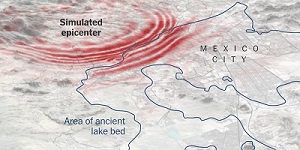
Virtual representation of the 19 September 2017 earthquake. Source: New York Times
When an earthquake strikes, the sediments the city is built upon slow the shock waves, leading to them strengthening and becoming more violent. To make matters worse the area is prone to earthquakes as it is near to the meeting of renowned tectonic plates.
This geological knowledge is not new so the question remains: why are Mexico’s buildings not better prepared for earthquakes?
According to the New York Times, building inspectors and private engineers have said that the strict building codes are not being enforced. A 2016 study revealed that many buildings failed to meet city standards - a staggering 71 percent of the 150 buildings studied, failed to meet standards.
A school that collapsed during the 19 September earthquake was marked safe by city inspectors after the earthquake 12 days earlier, on the 7th of September.
The Vice President of the Mexican Society of Civil Engineers, Sergio Alcocer said:
“We are concerned if we have a huge earthquake like the one in 1985 we may have problems in buildings. It’s a wake up call.”
Even the most recently constructed blocks of apartments in Mexico City tumbled down during the earthquake.
Buildings using concrete are said to be lacking vital reinforcing bars with concrete columns facing catastrophic failure during an earthquake if not properly reinforced. This apparently was the case in the collapsed Enrique Rebsamen school. 26 children lost their lives.
There is an urgent need for the review of civil engineering practices and standards in Mexico. More importantly, however, is the determination to enforce them.
Works Cited
White, Derek Watkins And Jeremy. “Mexico City Was Built on an Ancient Lake Bed. That Makes Earthquakes Much Worse.” The New York Times, The New York Times, 2017, www.nytimes.com/interactive/2017/09/22/world/americas/mexico-city-earthquake-lake-bed-geology.html?mcubz=1.
“A Building Suddenly Collapsing after a 7.1 Earthquake Strikes Mexico City. - Can Someone Explain Why There Is No Resistance as It Came down. • r/Engineering.” Reddit, www.reddit.com/r/engineering/comments/72armp/a_building_suddenly_collapsing_after_a_71/.
War. What is it good for? Competition.
Smartphone companies have released their latest devices, all vying for a space in your pocket.
Smartphones bring together a plethora of engineering and design disciplines to create incredibly multifaceted devices that have no doubt changed the way humans interact with technology. And there seems to be no stopping the effect they have on consumers. We all want a new one, every year or two. And the competition usually sends engineers into all-out design frenzy to create new functionality they think will excite and buy-over the consumer.
Apple
 Apple has released the specs of their latest smartphone, introducing a host of new engineered additions to the flagship device, the iPhone X. The phone has been released to coincide with the release of the first iPhone, exactly 10 years ago. The company also released an iPhone 7 successor, the iPhone 8, which has impressive augmented reality features.
Apple has released the specs of their latest smartphone, introducing a host of new engineered additions to the flagship device, the iPhone X. The phone has been released to coincide with the release of the first iPhone, exactly 10 years ago. The company also released an iPhone 7 successor, the iPhone 8, which has impressive augmented reality features.
Head of Apple, Tim Cook, said that the release of the $999 iPhone X would ‘set the path for technology for the next decade’. The phone boasts an extended battery life when compared to the iPhone 7. More interestingly, the phone utilizes a new phone unlocking method called ‘FaceID’. Meaning, its users can gain access to their phone, and confirm purchases using the smartphone’s facial recognition capabilities.

The company does this through specialized hardware built for a set of machine learning algorithms - it also works with their Truedepth camera system that can even see a face in the dark thanks to an infrared camera and dot projection technologies.
The Apple engineering teams worked tirelessly to protect FaceID from imposters, utilizing mathematical models that map the face of the phone owner. The company says that the odds of another human being unlocking your phone are 1 to 1,000,000.
One ‘feature’ that Apple announced had already been a feature of Samsung devices, but they are carrying it further – the new iPhone X is basically ‘all-screen’ from edge to edge, and from top to bottom.
Samsung
Samsung, with their exploding Galaxy Note 7s in mind, came back swinging by bravely announcing a new line of Galaxy devices that were equipped with ‘Infinity Displays’. In retrospect, Samsung beat Apple to the punch with a larger screen surface.

The screens almost run the entire length of the phone, and they comb around the sides of the device - this was a main feature of their new Galaxy S8 and S8+ range.
But Samsung are venturing into even cooler territory. Reports suggest that, if all goes well, Samsung will launch a bendable smartphone in 2018. Bendable and wearable devices are the new in-thing for electronic and electrical engineering industries. Engineers have to adapt accordingly.
Samsung had already been alluding to eventual bendable devices in concept advertisements dating back to 2014. Other companies like Lenovo have also showed off concepts relating the future of the bendable device:
If the engineering limitations of bendable devices can be figured out in time they may be with us as soon as 2018, so says Koh Ding-jin, president of Samsung’s mobile business:
“As the head of the business, I can say our current goal is next year. When we can overcome some problems for sure, we will launch the product.”
The bendable smartphone may set an even greater precedent in the smartphone engineering industry and would be an even greater leap for technology than Apple’s iPhone X.
Further Chinese dominance and AI
 Don’t discount the other Chinese heavyweights that have entered and set precedents in the game. Huawei has slowly risen to the top to become countries like Africa’s first choice when it comes to purchasing smartphones. They are the second largest smartphone manufacturer in the world, as of September 2017.
Don’t discount the other Chinese heavyweights that have entered and set precedents in the game. Huawei has slowly risen to the top to become countries like Africa’s first choice when it comes to purchasing smartphones. They are the second largest smartphone manufacturer in the world, as of September 2017.
And they’re heavily investing into a Mobile AI that will allegedly dethrone Apple’s Siri. Apple’s machine-learning rhetoric with their iPhone X is paving the way for a much larger AI announcement, if recent reports are to be believed. Whoever engineers a functioning artificial intelligence, and port it into a smartphone, will win the smartphone game, predict analysts.
Google recently announced a partnership between them and Chinese company Xioami. They will enter 40 countries and then, along with Google, they will bring out an Android device that they hope will see consumer uptake.
The smartphone manufacturing game seems to bring together many engineering industries and pit them against each other to see who can design and develop the most desirable features for consumers. It is an exciting time for engineers with imagination and design capability.
Works Cited
“Design - 6.3’ Infinity Display | Samsung Galaxy Note8 – The Official Samsung Galaxy Site.” The Official Samsung Galaxy Site, www.samsung.com/global/galaxy/galaxy-note8/design/.
Lechman, Ashley. “Huawei Aiming for the Top Spot.” IOL Business Report, 2017, www.iol.co.za/business-report/huawei-aiming-for-the-top-spot-11017393.
McGoogan, Cara. “Apple Unveils IPhone 8 and £1,000 IPhone X with All-Screen Display and Wireless Charging .” The Telegraph, Telegraph Media Group, Dec. 2017, www.telegraph.co.uk/technology/2017/09/12/apple-iphone-8-iphone-x-launch-event-live-updates/.

Are you after an exciting job that takes you around the world?
Actura is looking for a Tour Group Manager who will be trained to facilitate guided tours around the NASA space grounds in the United States!
About Actura
Actura Australia offers a world-class learning environment as the exclusive Australian partner of the Space School international study programs; and the worldwide partner delivering CASE curriculum-based robotics program. Established in Australia in 2014, Actura'a Australian team have delivered expeditions including students from 200 schools nationwide. As an innovative business, Actura has developed strong partnerships to bring Australian students the best of international STEM-skilled programs.
Actura focuses on the education of students by providing programs designed to broaden their minds, cultivate their drive, instill curiosity and the spirit of exploration, along with the values of pursuing learning excellence. In Australia, Actura is responsible for forming groups of participants from high school students; managing those customers (school management, students and parents); booking all flights; appointing and training tour staff; and liaising with US operations to organise the on-the-ground tour component.
Details
For further information on Actura, please visit their website: http://actura.com.au/
It is time to plan your reward for all the hard work you have put into your studies with the Engineering Institute of Technology!
You spoke and we listened!
Due to popular demand we will have two Graduate Galas in 2018:
- Midrand, South Africa: 18th of October 2018
- Perth, Australia: 23rd of November 2018
We are excited to celebrate our graduates during two very special events in the vibrant locations of Perth (Australia) and Midrand (South Africa). These will be memorable gatherings with the unique opportunity to receive your Diploma and a special token of appreciation directly from the hands of EIT’s Dean of Engineering, Dr Steve Mackay.
You will be able to meet our College Managers, some of our wonderful Learning Support Officers and Lecturers who assisted you in your studies and hear from inspirational speakers. Read more below and do not miss the opportunity to apply for the Graduate of the Year Award.
If you would like to attend an EIT Graduate Gala, please make sure you complete the form available on this webpage indicating your location preference.
Australian Graduate Gala
EVENT DETAILS
- Date: Friday 23rd of November 2018
- Time: 6:00pm to 8:30pm. Arrival by 5:30pm for prompt start
- Location: Green Building EIT Campus - 140 Royal Street, East Perth, Western Australia
- Dress code: Cocktail Attire
- Cost: Complimentary for all EIT graduates
- Accommodation: if you require accommodation in Perth you can contact the event coordinator, Carolina Asenjo, to find out about possible discount options for EIT graduates
- Tourism activities: Perth and the whole of Western Australia have plenty to offer visitors and the time of the year will provide fantastic weather to wonder around the many parks, beaches and natural reserves, among other attractions. You can find out more with the Tourism Department of Western Australia, Expedia or Bookme
- Valid Visitor Visa or Passport: You may need a valid visa/passport to allow you to come to Australia for this event. The Australian Department of Immigration and Border Protection has a very detailed website you can visit for more information: https://www.border.gov.au/.
- Event Coordinator: Carolina Asenjo,
This email address is being protected from spambots. You need JavaScript enabled to view it.
SPEAKERS
Mr Ron Manners
His long career has taken him to a number of major world events such as the fall of the Berlin Wall, the collapse of communism in Russia and the Hong Kong handover. Mining is in Ron’s blood. He started out as an electrical engineer, training at Kalgoorlie School of Mines, and took over the family business in 1955. The mining industry has seen a number of changes in the past 60 years, such as the introduction of new technologies, and Ron has weathered this with humility, enthusiasm and good humour. As a proponent of the free market model, Ron set up Mannkal Economic Education Foundation, a think-tank that sponsors students and events. Ron is also a book author, including titles such as Poems of Passion, Heroic Misadventures, and Never a Dull Moment.
Mr Cameron Norsworthy
Cam is a coach, entrepreneur, author and speaker. He focuses on integrated coaching techniques that encourage sustainable transformations and rewards and has coached numerous World Champions, executives, entrepreneurs, and high profile military personnel. In 2013, Cameron founded The Flow Centre to align his training and passions and put Flow in the public eye.
Mr Partha Dev
Partha has 30 years of Civil Structural Engineering & Management experience in the oil and gas sector. He has worked on major capital projects involving fixed and floating offshore structures, onshore hydrocarbon, LNG facilities, power, mining and infrastructure assets and is known in the industry for his ground-breaking work in structural reliability assessment. Partha is passionate about mentoring students and professionals. He is also an adept problem solver and received the coveted E. Paul Torrance Australian Coach’s award from the Future Problem Solving Program committee in 2017.
South African Graduate Gala
EVENT DETAILS
- Date: Thursday 18th of October 2018
- Time: 11:00am to 1:00pm
- Location: Midrand Conference Centre, Midrand, Johannesburg
- Dress code: Cocktail Attire. Graduation Gowns can be hired. Specific hood colours apply per School.
- Cost: Complimentary for all EIT graduates. Additional guests can attend by paying R345 each
- Accommodation: if you require accommodation in Midrand you can contact the event coordinator to find out about possible discount options for EIT graduates
- Tourism activities: Johannesburg in South Africa is the second largest city in Africa, Joburg, or Jozi as some prefer to call it, offers visitors an experience as unique and diverse as the city itself and the surrounding areas. Browse through the multitude of wonderful attractions and things to do in Gauteng as well as a dazzling array of options for everything from accommodation to car rental, restaurants, shopping and casinos, etc. https://www.gauteng.net/ https://www.joburgtourism.com/tourist-information
- Valid Visitor Visa or Passport: You may need a valid visa/passport to allow you to come South Africa. Please visit the South African Home Affairs Department for more information: https://www.dha.gov.za/
- Event Coordinator: Apolonia Pamuri,
This email address is being protected from spambots. You need JavaScript enabled to view it.
SPEAKERS
Mr Terry Cousins
Terry has over 30 years of experience in electrical power and distribution systems in various South African industries. He is currently a director of TLC Engineering Solutions who develops instrumentation and measurement systems for industry. He also presents courses on electrical power distribution and power quality. Terry is a Senior Member of the SAIEE, and a Member of the IEEE (USA) and has also served on the South African National Standards committee for power quality instruments (SANS 1816).
Mr Deon Reynders
Deon is an Electronics Engineer with over 40 years postgraduate experience encompassing middle management, engineering consulting, management consulting, hardware and software development, systems engineering, project management, marketing, and industrial relations. Over the past 15 years he has provided consulting and training services to clients in USA, Canada, Ireland, the UK, South Africa, Botswana, Trinidad, Australia, New Zealand, Indonesia, Singapore, Malaysia, Thailand, Malaysia, Myanmar, Saudi Arabia, Oman and Egypt. He is also co-author of several technical books.
Mr Tom Neillings
Tom started his career as an engine fitter in the RAF. After leaving the RAF he worked in oil and gas North Sea projects. During this period he gained valuable experience and knowledge of diesel power generating systems operating in harsh environments. Tom continued his career in South Africa with a short period in Saudi Arabia. Tom's down-to-earth and practical, yet entertaining approach makes him a sought after speaker and instructor. His enthusiastic approach to training coupled with his helpful nature is guaranteed to maximize the learning outcome for his students.
EIT Graduate of the Year Application
Applications Open
This is your opportunity to gain the ultimate feather in your cap. Complete the application form available here http://www.eit.edu.au/downloads/2018_EIT_Graduate_of_the_Year_Application_PDF_Form.pdf and send it to Carolina Asenjo (
The winner will receive:
- A complimentary place on an EIT Professional Certificate of your choice. The course must have enough paying students to go ahead and must be completed by December 31, 2019
- A write-up of your achievement in EIT’s website, social media platforms and eNewsletter which is circulated to over half a million engineering professionals worldwide
- Electronic access to the complete IDC Technologies electronic library of technical manuals for 1 year
- An Acer tablet (or equivalent gift) valued at $250 r.r.p.
- Commendation at the Graduate Gala ceremony
All finalists will also receive a prize for their achievement.
Do not miss this unique opportunity to celebrate your academic achievement, network with key industry contacts, and enjoy a beautiful location



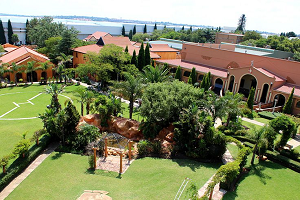


REGISTER YOUR INTEREST FOR THE 2018 EIT GRADUATE GALA
{uniform form=83/}
Mr Coffee to the rescue…
They say that money can’t buy happiness – but $999 can buy a Wi-Fi enabled coffee machine, and we think that comes pretty close! This advanced coffee machine, named Mr Coffee, makes coffee for you at your convenience with just a tap of your smartphone using Wi-Fi connectivity. What’s not to love? The only disadvantage we can identify is that Mr Coffee (pictured below) does not come with a walking robot to have the coffee delivered to your sofa as well!

Click here to view Mr Coffee on Amazon.
Man undergoes elective amputation to be fitted with bionic arm
Due to being involved in a motor accident, a man named Milo lost functionality in his arm and therefore decided to voluntarily undergo amputation. His arm has been replaced with astonishingly intelligent wearable technology: a bionic arm, which allows him to have increased functionality. Manufactured by German prosthetics company Otto Bock, the arm is comprised of six sensors that pick up the neuronal signals sent to the forearm from the brain to control arm and hand movement. Electrical signals are converted into mechanical movement for maximised mobility.
To take a look at Milo's incredible journey with this wearable technology, click the video below:
Would you ride in a driverless sky vehicle?
Dubai is racing to become the first to have a sky transport network using Volicopters, pictured below.
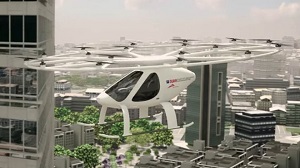
The Volicopter is claimed to be able to run at a top speed of 100km/h with a maximum flight time of 30 minutes. Nine independent battery systems ensure safety, and it has been assured that the on-board parachute system will “never be required”. Dubai will begin a 5 year testing period of the Volicopter later this year – but the real question is, would you trust your life with this new technology?
'Human on a chip’: Could this be an alternative to animal testing?

Image: Human on a chip. Credit: fastcompany
For decades now, testing products on animals has been a point of concern and controversy that has caused companies to receive significant public criticism. However, thanks to developing technology, using lab rats or other animals for psychological, biological and physical experiments could become a thing of the past with the invention of the ‘human on a chip’. Lawrence Livermore National Laboratory are working on developing new technology that essentially replicates vital human tissues onto microchips, for testing. Instead of testing on live animals, ‘Human on a chip’ aims at testing on non-conscious human cells, which will then be exposed to chemicals and electrical signals for the experiments (just like any other lab animal).
To read more on this amazing technology, click here.
-Works cited
Dar, Talha. 17 Sept 2017. “10 Best Tech Gadgets For Your Home”. Wonderful Engineering. http://wonderfulengineering.com/10-best-tech-gadgets-for-your-home/
K, Maarej. 4 Sept 2017. Man Undergoes Elective Amputation To Get A Robotic Arm. Wonderful Engineering. http://wonderfulengineering.com/man-undergoes-elective-amputation/
Belton, Padraig. “Would you take a ride in a pilotless sky taxi?” 1 September 2017. BBC. http://www.bbc.com/news/business-41088196
Sohail, Umer. 11 Sept 2017. “‘Human On A Chip’ Is The Latest Technology That Can Replace Animal Testing”. Wonderful Engineering. http://wonderfulengineering.com/human-chip-technology/
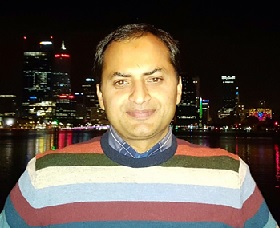
“I have thoroughly enjoyed the online Master of Engineering in Industrial Automation through EIT."
"It has been difficult two years juggling between work, family and study but well worth it as I have gained a lot more knowledge and confidence to do my job well.
The delivery of online course was exceptional as I had a chance to interact with lecturers as well as other students from the luxury of my own place. In the beginning I was bit skeptical about the online mode of education but the exceptional delivery of online Masters by EIT has changed my opinion. The course was delivered by industry professionals with decades of experience who passed on wealth of information and the most relevant knowledge needed to be successful in the world of Industrial Automation. In the end, I am quite happy that I selected Masters of Engineering (Industrial automation) as post-grad degree and chose EIT as the course provider.”
Muhammad Naveed-Ul-Hassan
Control Systems Engineer
Nickel West
Kalgoorlie Nickel Smelter & Concentrator
Cars are becoming more like smartphones every day. But is that necessarily a good thing? And what does it mean for the engineers who want to make a career out of automotive engineering? The days of the combustion engine seem to be coming to an end. The desire of tech companies and vehicle manufacturers is now to create fully autonomous, environment-friendly vehicles that takes individuals from point A to point B.
Elon Musk’s Tesla Motors is a good example of where the electric/smart vehicle market is going - customers seem to respond well to what is seemingly the future of mobility. However, it has been a rocky road for Tesla and its software-driven vehicles.
In 2016, a man lost his life in a Tesla car, after the Autopilot hardware and software inside the Tesla vehicle failed to recognize a trailer in the middle of the freeway.
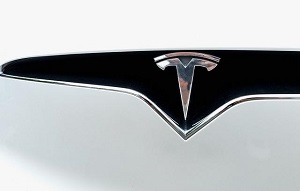
A year before that, Fiat Chrysler had to recall 7,810 Jeep Renegades with automated systems that could be exploited by hackers; a danger that they could be ‘remotely manipulated’. In response the company released USB sticks that would remedy the vulnerabilities and uploaded a safety update to the vehicles - it turned out that 1.4 million needed the update.
It follows then that as vehicles become more and more like computers they will need constant security upgrades.
Green-lighting OTA
On-the-fly software updates to the firmware inside vehicles are increasing rapidly. General Motors is the latest company to join the fray of vehicle manufacturers that are securing over-the-air (OTA) upgrades to their cars via a remote network. They can upgrade their network of vehicles with a click of a button, delivering specifically engineered code to their fleet of vehicles simultaneously
Software updates to a vehicle are becoming as easy as installing an app on a smartphone. According to ABI Research, 180 million new vehicles shipping between 2016 and 2022 will see the adoption of automotive over-the-air software updates.

“Three factors changed the course of the automotive industry and paved the way for the future of OTA: recall cost, Tesla’s success as the foundation of autonomous driving, and security risks based on software complexities,” said senior research analyst at ABI Research, Susan Beardslee. “It is a welcome transformation, as OTA is the only way to accomplish secure management of all connected car’s software in a seamless, comprehensive, and fully integrated manner.”
However, cybersecurity is a common concern among those critical of OTA updates. But with faster communication to the entire fleet of vehicles with OTA, the chances of blocking hackers’ attempts on vehicles could be more efficient than having to prevent hacking on individual vehicles as the need arises.
It is clear that the need for cybersecurity engineers in automotive engineering will grow and will need agile higher education institutions to step up.
Engineers interested in cars today can either work with the tech companies (like Apple, who are designing a fully autonomous car) or stick with the tried-and-tested vehicle manufacturers. The market is becoming more multi-faceted and interesting; a broader range of skills are required in the automotive engineering space than ever before.

Battery similarities
Automotive engineering companies are investing in the smartphone-vehicle-likeness by making vehicles battery powered. Lithium-ion batteries are found in our phones and will power your next car, but obviously on a grander scale.
After an emissions scandal, Volkswagen have pledged that they will invest up to $24 billion into zero-emissions vehicles by 2030 to try and challenge the already blossoming Tesla Motors. Volkswagen said that they will be manufacturing 80 new vehicles across its group by 2025. The company also wants to offer its other 300 group models in electric versions by 2030, Reuters confirms.
It seems there is no turning back for the unprecedented change the automotive engineering market is undergoing with the combustion engine heading into retirement? China has just announced that they will ban combustion engines within vehicles by 2040. Future engineers will become increasingly involved in e-mobility era in automotive engineering.
Works Cited
"ABI Research Anticipates Accelerated Adoption of Automotive Software Over-the-Air Updates with Nearly 180 Million New SOTA-Enabled Cars Shipping Between 2016 and 2022." ABI Research. Web. 11 Sept. 2017.
"As Your Car Becomes More like an IPhone, Get Ready to Update Its Software Regularly." Phys.org - News and Articles on Science and Technology. Web. 11 Sept. 2017.
Cremer, Andreas. "Volkswagen Spends Billions More on Electric Cars in Search for Mass Market." Reuters. Thomson Reuters, 11 Sept. 2017. Web. 11 Sept. 2017.
Mazda has reinvented the wheel. Or rather, they claim they have reinvented the engine which drives that wheel.
They have engineered a ‘SkyActiv-X’ series of engines which purportedly use game-changing technologies which they believe will save the combustion engine from its seemingly inevitable demise.
The new engines use ‘Homogenous Charge Compression Ignition (HCCI)’. It is thought to be the ‘holy grail’ of combustible engines in a world which demands lower emissions.
SkyActiv-X shuffles between diesel engine compression and common spark ignition combustion engines in a best-of-both-worlds approach. They have assigned a name to this process; Spark Controlled Compression Ignition.
Mazda explains that this process of jumping between two kinds of compression can ensure that the engine works 20 to 30 percent more efficiently than its predecessors. HCCI engines are superior to that of standard gasoline and diesel engines because they remain cooler, resulting in a reduction of nitrogen oxide emissions.
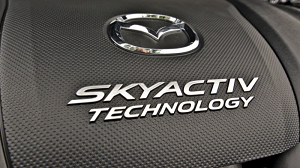
The Mazda Motor Corporation has developed this next-generation engine to fit into their new long-term strategy aptly named ‘Sustainable Zoom Zoom 2030’. In terms of the details, however, Mazda is playing its cards close to its chest. As the cars near their release dates in late 2018, early 2019 more should emerge.
The question that persists with HCCI development is whether or not governments will trust further iterations of combustible engines as the world’s environmentalists call for the advancement of electrification.
Is it all for naught?
Britain has joined the list of countries determined to move to electric vehicles. They plan to ban the sales of petrol and diesel cars (and vans) from 2040 in an effort to curb nitrogen oxide levels in the country.
“Poor air quality is the biggest environmental risk to public health in the UK and this government is determined to take strong action in the shortest time possible. That is why we are providing councils with new funding to accelerate development of local plans, as part of an ambitious £3 billion program to clean up dirty air around our roads,” a government spokesperson said.
Governments have traditionally veered away from nuclear energy due to high profile incidents. Similarly, due to an increasing deluge of bad press, there is an increasing tendency to reject technologies that use ‘combustion’ and ‘engine’ in the same sentence. Furthermore, claiming to commit to a future of safer, electric-powered vehicles is a politically savvy decision at present.

The war against combustion engines could make Mazda’s last ditch effort for the ideal internal combustion engine an engineering non-starter. Mazda’s Research and Development head Kiyoshi Fujiwara says: “Electrification is necessary but...the internal combustion engine should come first.”
Germany’s Angela Merkel, despite the pressure of world-renowned German automotive engineering companies, has also issued statements pointing to the retiring of internal combustion engine technologies. In a recent speech she said:
“Large sections of the auto industry have gambled away unbelievable amounts of trust. This is trust that only the auto industry can restore. And when I say ‘the industry’ that is the company leaders.”
Critics, however, say that the move to electrification in Germany may cause 900,000 job losses in the country. What remains clear is that the pressure on phasing out the internal combustion engine vehicle for the next big thing in vehicle engineering technology is going to be a bumpy road.
Works Cited
Asthana, Anushka, and Matthew Taylor. "Britain to Ban Sale of All Diesel and Petrol Cars and Vans from 2040." The Guardian. Guardian News and Media, 25 July 2017. Web. 16 Aug. 2017.
Jamieson, Craig. "Here's How Mazda Plans to save the Internal Combustion Engine." Top Gear. Top Gear, 08 Aug. 2017. Web. 16 Aug. 2017.
Old-timers, let alone prospective engineers, can sometimes get lost in the buzzwords that the industry throws at them. And then there are those skills that are hugely useful, but not adequately covered within an engineering curriculum. Critical thinking is both a buzzword and an intangible, soft, but incredibly handy skill.
But what is critical thinking? The National Council for Excellence in Critical Thinking in 1987 fashioned a definition:
“Critical thinking is the intellectually disciplined process of actively and skillfully conceptualizing, applying, analyzing, synthesizing, and/or evaluating information gathered from, or generated by, observation, experience, reflection, reasoning, or communication, as a guide to belief and action.”
Critical thinking then, is the kind of skill an engineer should be equipped with before moving forward into an engineering career. The question is: Can critical thinking be taught? Educational institutions are attempting to impart this illusive skill before students even reach the tertiary education level.
How institutions are doing it today
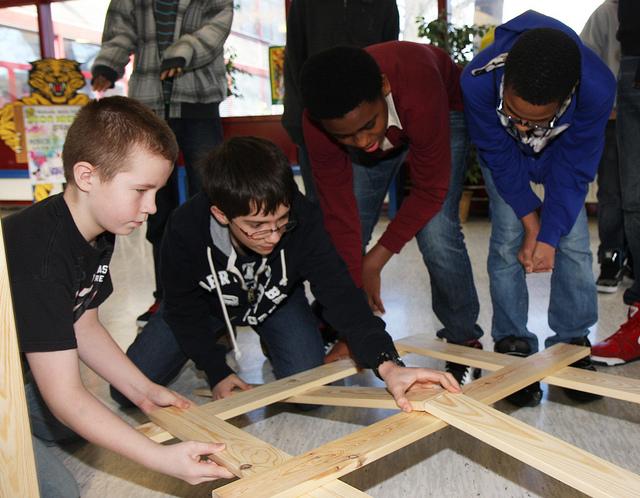 Many educators providing subjects which a focus on science, technology, engineering and mathematics (STEM) are using various initiatives to inspire critical thinking and problem solving. Examples of these are school clubs for robotics’ enthusiasts, electric circuit board projects, and general engineering weeks. Students who are involved get to physically tamper with actual, tangible engineering elements during class; to nut out solutions, to nurture and discipline their creativity streaks. Some schools are hosting STEM-camps that provide children the opportunity to problem solve and tap into their more advanced levels of cognition.
Many educators providing subjects which a focus on science, technology, engineering and mathematics (STEM) are using various initiatives to inspire critical thinking and problem solving. Examples of these are school clubs for robotics’ enthusiasts, electric circuit board projects, and general engineering weeks. Students who are involved get to physically tamper with actual, tangible engineering elements during class; to nut out solutions, to nurture and discipline their creativity streaks. Some schools are hosting STEM-camps that provide children the opportunity to problem solve and tap into their more advanced levels of cognition.
Critical thinking and problem solving are encouraged within STEM-focused subjects, but some institutions reckon that to ably facilitate students to adopt these skills something is being left out.
Hence the rise of STEAM: science, technology, engineering, arts and mathematics. Educators have begun adding subjects usually relegated to the Arts to inspire and improve analytical thought from students preconditioned to mastering STEM-focused subjects. For critical thinking to occur self-awareness and emotional intelligence are useful and these skills are ignored or may get lost, through a lack of nurturing, when students focus on STEM alone. There is a shift occurring: subject matter from the Humanities Faculty is entering engineering curriculums.
Bloom’s Taxonomy
Engineers might have their institutions of education to thank for the careers they have today; many schools during the last few decades have utilized the psychological framework of Benjamin Bloom.
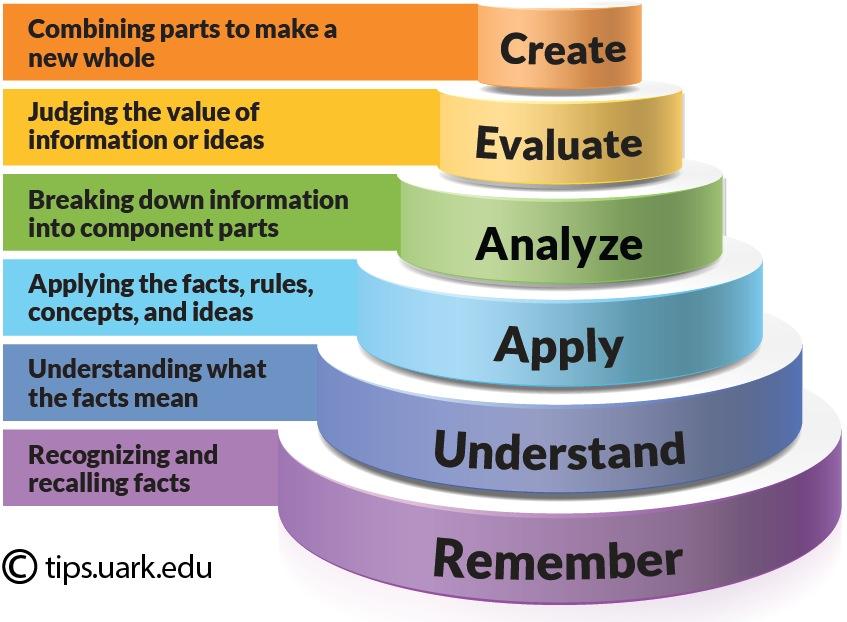 Bloom was an American educational psychologist who contributed to the theory of mastery learning in the 50s. Some of his systems are used by schools and universities to this day. Many of his findings, on the levels of learning, are undeniably useful for the teaching of engineering. For exams, assignments, and general engineering projects, his six levels of learning can help an engineer improve both their knowledge and their efficiency and boost their critical thinking skills simultaneously:
Bloom was an American educational psychologist who contributed to the theory of mastery learning in the 50s. Some of his systems are used by schools and universities to this day. Many of his findings, on the levels of learning, are undeniably useful for the teaching of engineering. For exams, assignments, and general engineering projects, his six levels of learning can help an engineer improve both their knowledge and their efficiency and boost their critical thinking skills simultaneously:
1. Knowledge - count, define, describe, draw, find, identify, label, list, match, name, quote, recall, recite write
2. Comprehension - conclude, demonstrate, discuss explain, generalize, identify, illustrate, interpret, paraphrase, predict, report, restate, review, summarize, tell
3. Application - apply, change, choose, compute, prepare, produce, role-play, select, show, transfer, use
4. Analysis - analyze, characterize, classify, compare, contrast, debate, deduce, diagram differentiate, discriminate, distinguish, examine, outline, relate, research, separate
5. Synthesis - compose, construct, create, design, develop, integrate, invent, make, organize, perform, plan, produce, propose, rewrite
6. Evaluation - appraise, argue, assess, choose, conclude, criticize, decide, evaluate, judge, justify, predict, prioritize, prove, rank, rate, select.
Through Bloom’s Taxonomy, designs and calculations can undergo levels of variance that can improve an engineer’s approach to projects and strengthen his/her ability to think critically.
Graduates need critical thinking - it’ll get them the job
Ersnt and Young, the multinational professional services company, believes critical thinking can set you apart as a graduate.
“Academic qualifications will still be taken into account and indeed remain an important consideration when assessing candidates as a whole, but will no longer act as a barrier to getting a foot in the door. Our own internal research of over 400 graduates found that screening students based on academic performance alone was too blunt an approach to recruitment.”
And as Einstein claimed: “The value of a college education is not the learning of many facts, but the training of the mind to think.”
Works Cited
Defining Critical Thinking. Web. 29 Aug. 2017.
Bloom, Benjamin Samuel. Taxonomy of Educational Objectives. N.Y.: Longmans, Green, 1956. Print.
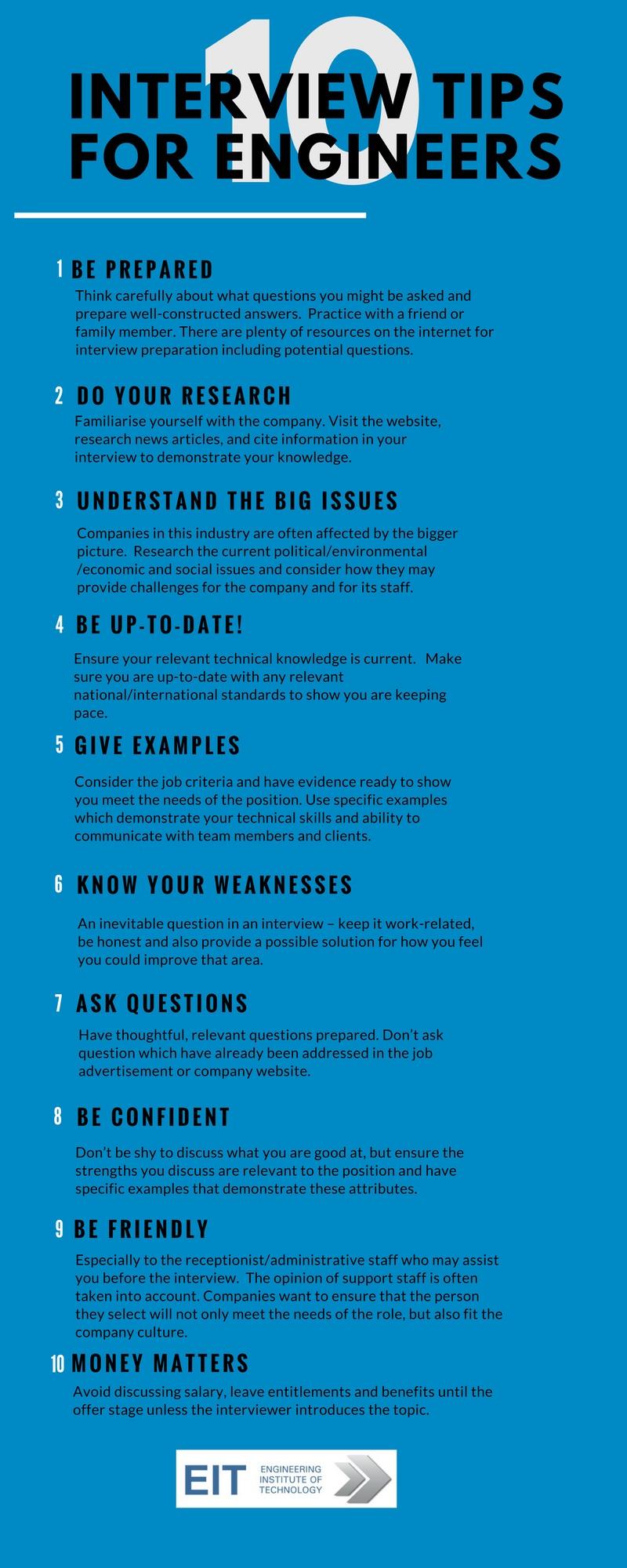
Be prepared. Think carefully about what questions you might be asked and prepare well-constructed answers. Practice with a friend or family member. There are plenty of resources on the internet for interview preparation including potential questions.
Do your research. Familiarise yourself with the company. Visit the website, research news articles, and cite information in your interview to demonstrate your knowledge.
Understand the big issues. Companies in this industry are often affected by the bigger picture. Research the current political/environmental /economic and social issues and consider how they may provide challenges for the company and for its staff.
Be up-to-date! Ensure your relevant technical knowledge is current. Make sure you are up-to-date with any relevant national/international standards to show you are keeping pace.
Give Examples. Consider the job criteria and have evidence ready to show you meet the needs of the position. Use specific examples which demonstrate your technical skills and ability to communicate with team members and clients.
Know your weaknesses. An inevitable question in an interview – keep it work-related, be honest and also provide a possible solution for how you feel you could improve that area.
Ask Questions. Have thoughtful, relevant questions prepared. Don’t ask question which have already been addressed in the job advertisement or company website.
Be confident. Don’t be shy to discuss what you are good at, but ensure the strengths you discuss are relevant to the position and have specific examples that demonstrate these attributes.
Be friendly. Especially to the receptionist/administrative staff who may assist you before the interview. The opinion of support staff is often taken into account. Companies want to ensure that the person they select will not only meet the needs of the role, but also fit the company culture.
Money matters. Avoid discussing salary, leave entitlements and benefits until the offer stage unless the interviewer introduces the topic.
 Advancing from technician, to engineer, to senior engineer, to management, to the 30-years-of- service gold watch at retirement. Is this the picture of an ideal career trajectory? Is it realistic?
Advancing from technician, to engineer, to senior engineer, to management, to the 30-years-of- service gold watch at retirement. Is this the picture of an ideal career trajectory? Is it realistic?
To bolster CVs or resumes engineers look to work for major companies and then hope for promotions within them. In an effort to have the edge they attempt to remain abreast of the shifts in industry and galloping technology. To this end continuing professional development, and indeed qualification upgrades, can help.
Unfortunately acquiring new and relevant skills does not always equate to moving upwards in a company. To be positioned well for specific promotional positions in a company is difficult and to add to the challenge there are other equally driven team members in the race too.
What do engineering companies want?
Some institutions offering engineering education and training closely monitor the shifts within engineering disciplines, in an effort to offer courses that ensure students receive industry-relevant qualifications. But this alone is not always enough. Students also need to have nurtured certain qualities which will benefit a company.
For example, IT and engineering are intersecting and engineering courses are now including modules once never utilized. It is, however, up to engineers to grow their skill sets across disciplines and industries (including skills which are not all technical), to position themselves for better career prospects.
Iowa State University has outlined 15 skills employers most want to see in engineering graduates:
- Engineering knowledge
- Communication
- Professionalism
- Planning
- Safety Awareness
- Quality Orientation
- Cultural Adaptability
- General knowledge
- Innovation
- Teamwork
- Continuous learning
- Analysis & Judgement
- Integrity
- Customer focus
It is becoming clear that engineering employers today require engineers to be multitalented. Gone are the days when engineers could disappear behind the scenes within a certain skill set; now they need to work on becoming entrepreneurial and capable across industries.
Flexibility is key, particularly for ambitious engineers and for those who would like to start their own businesses.
You’re in...now what?
Once in a company engineers must prove that they can deliver efficient performance that benefits the company in order to gain promotions. This can sometimes be achieved through getting Six Sigma certification.
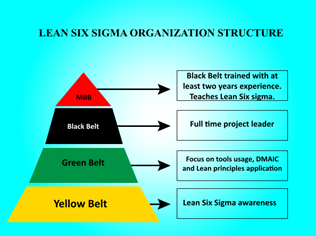
Source: Wikipedia
Six Sigma is a set of quality and process analysis techniques developed within Motorola in the 1980s. Thereafter, in 1995, it was turned into business and employment requirements by General Electric. It refers to the training and processes engineers can utilize within a company to minimize waste and work efficiently on their projects.
The levels are referred to as Belts (similar to those used in the Martial Arts). The levels progress upwards through the belt colors with each achieved through the defining, measuring, analyzing, improving and controlling of the assigned projects within the company. The engineer who reduces process cycle time, reduces costs and increases customer satisfaction has a better chance of getting promoted within an organization.
Getting certified in Six Sigma may make an engineer stand out, particularly in a business which requires a mandatory level of certification in the methodology.
There is, however, any number of ways to skin a cat, as the saying goes. There are many who would swear that Six Sigma can fine-tune working environments, but it has also been suggested that it can drain employer creativity. And what are engineers without this?
Some intelligent comments follow. They point out some simple truisms:
Nothing great was ever achieved without enthusiasm – Ralph Waldo Emerson
There are no secrets to success; it is the result of hard work, preparation and learning from failure – Colin Powell
Success is liking yourself, liking what you do and how you do it – Maya Angelou
And the final one advises that we hone our ability to work as part of a group:
Great things in business are never done by one person. They’re done by a team of people – Steve Jobs
Works Cited
"Understanding What Employers Look for in Engineers." Engineering Career Services. Web. 18 Aug. 2017.
Wheat, Barbara, Chuck Mills, and Mike Carnell. Leaning into Six Sigma: The Path to Integration of Lean Enterprise and Six Sigma. Boulder City, NV: Pub. Partners, 2001. Print.
Golding, Ian. shhhhh-dont-mention-six-sigma-the-truth-behind-the-stigma Web. 16 Sept. 2013
https://www.prdaily.com/Main/Articles/30_inspiring_quotes_about_business_marketing_and_c_14073.aspx
Dear Colleagues,
 Last night at a Careers Expo attended by happy throngs of kids and parents, one dad (a practising engineer) indicated to me that he had advised his two kids who were shortly finishing high school to avoid an engineering career and to focus on more lucrative jobs such as in law or merchant banking. I sympathise with him as many of my engineering friends have been caught out in the intermittent ‘down draughts’ and thrown onto the streets.
Last night at a Careers Expo attended by happy throngs of kids and parents, one dad (a practising engineer) indicated to me that he had advised his two kids who were shortly finishing high school to avoid an engineering career and to focus on more lucrative jobs such as in law or merchant banking. I sympathise with him as many of my engineering friends have been caught out in the intermittent ‘down draughts’ and thrown onto the streets.
I am not so sure though
However, I am not so sure that lawyers and merchant bankers are able to find good jobs either. There is a ferocious amount of automation going at present with a lot of legal jobs being automated (you can buy a proforma contract document for a few dollars or even an hour of cheap legal advice online nowadays). Business graduates are ‘a dime a dozen’ these days because of the massive growth in these university programs.
The challenge with Engineering Jobs
The reason why most of my engineering buddies have been ‘let go’ (i.e. fired) was because a particularly large project they were happily engaged on had suddenly finished. Generally this is often done unpredictably and driven by a sudden impatience in the client who had run out of patience (and money) in ever seeing the end of that particular project.
Others have lost jobs because of a change in technology meaning that their current company was increasingly unprofitable. Sometimes, these engineers worked for a start-up firm where the blue sky prognostications of the business entrepreneur had met reality in terms of massively disappointed investors who bolted for the exits when the losses seemed to go on forever. And suddenly everything was then shut down.
Other friends lost jobs because their skills had become outdated and they had lost their verve in constant reskilling and sharpening their knowledge. Some of them had often lost enthusiasm for their jobs – perhaps tired of doing the same old thing every day.
When you read the previous paragraphs, you may come to the conclusion that engineering is a hopeless case for someone looking to the future stability in income. I do believe you can deal with these issues in a proactive way.
There are Huge Opportunities in Technology and Engineering
You only need to look at some of the most profitable companies in the world – they are all based around engineering and technology. Such as Apple, Exxon Mobil, Samsung, Berkshire Hathaway (incl. rail and food) and Chevron. Companies largest by revenue such as Saudi Aramco, Shell, Volkswagen and Toyota also employ huge numbers of engineering professionals. There are huge and growing opportunities in the new technologies such as the Internet of Things, Cloud computing, automation and driverless cars. The list seems endless and constantly growing.
The key thing is to wrap yourself up in a ‘Secure-your-career’ blanket to deal with the sudden changes you may be exposed to such as described above.
What is a ‘Secure Your Career’ Blanket ?
When commencing your engineering career you need to plan for the worse but to rejoice in continuing good fortune. A few key elements here would include the following.
Business Skills are Critical
One area which I believe engineering professionals are short changed is in not having sufficient business skills. After all – the pointy business end is where the bills are paid and decisions are made in a company.
These sort of skills include finance/accounting/marketing and law. With this know-how; you can participate more effectively in your business and indeed help steer it out of choppy waters and keep it going. Or at least help management make good decisions by giving a business perspective to your engineering role. You can also quickly identify when things are becoming unsustainable with your current employer and start looking at alternative scenarios.
Consistent Achievers in Engineering
Following on my comments on business skills above, when I think of engineering colleagues who have done well consistently, it is those who are entrepreneurial and have strong business skills either formally or through on-the-job learning. As a result, they are more attuned to dodging the curved balls coming in from all directions – something which is increasingly the case these days. I know that ‘pure’ engineers will be somewhat disparaging about people with business skills remarking that they are no longer engineers but business people. But a mix of engineering and business skills definitely makes you more saleable and able to sustain your career.
Make Yourself Indispensable in your job
You should ensure that you are the go-to expert in your firm. Other skills that ensure you stand out are the ability to write and communicate well. This helps upper level management and other spheres of the business gain a better understanding of what you do and why you are valuable.
Stay up-to-date at all times
Keep sharp with your knowhow and skills level. Ensure that you are constantly learning new techniques and applying new technologies. Not necessarily attending formal courses but in linking with people engaged in pioneering work.
Finally, keep everything relating to your online career up to date. This means not only your resume but LinkedIn profile and other social media sites. Ready to go when things start breaking up around you and you need to move or to seize a new opportunity.
Overall
Overall, I believe having a job is akin to surfing. You can ride a really good wave for a while but eventually when you hit the shore you have to paddle back and look for the new wave. With different characteristics and twists and turns.
Always remember Alfred Montapert’s comment: ‘To accomplish great things we must first dream, then visualize, then plan... believe... act’
Yours in engineering learning
Steve
Were you born to be an engineer? Were you supernaturally gifted with the skills necessary to become an engineer? Or can engineering be taught? If you have an innate skill for taking things apart and putting them back together again, you might have an engineer living inside of you.
However, the world today has made it clear that there are certain requirements that must be met when considering whether a person can become a qualified engineer or not.
Mathematics & Science
It is a common held belief that it is very difficult to break into the engineering world, to study engineering without the relevant mathematics and science qualifications.
In South Africa, in 2016, 265,810 candidates wrote the mathematics examinations. The pass rate for those exams was only 51.5%. The class of ‘16’s average for mathematics was 30.8%. The numbers reveal that many must have failed to bring the average spiraling downward. Physical science saw a pass rate of 62%, with a class average of 35%. The implications of such low numbers is usually that students either have to repeat their final year, or forge ahead and find a job in an industry with no matriculation certificate. Unfortunately, with a 30% mark for maths and/or science, finding a job in industries demanding these subjects may be difficult.

To apply for a Bachelor of Science (in one of the streams of Engineering), through the Engineering Institute of Technology (EIT), 50% for mathematics and 50% for physical science is preferable, but assessments are made on a case-by-case basis. Once a student is given admission to the institution, an engineering mathematics bridging course soon follows. This gives those who require it, the level of mathematics needed to graduate as a technologist first and professional engineer second.
The willingness to embrace mathematics and science education can, however, be daunting and can certainly be the decider for students selecting study options and careers. These subjects do present a barrier to promising engineers, a barrier which seems to be growing and as a result causing the industry some consternation.
Engineers Australia has reported that the number of students studying science and mathematics is “in a free fall”. It further alleges that less than half of Australia’s engineers were born in Australia - highlighting the country’s over-reliance on skilled foreigners. In response STEM (Science, Technology, Engineering and Mathematics) subjects are being actively encouraged by schools. STEM-influenced materials and equipment are flooding schools in the belief that students will be inspired and subsequently select those careers founded on these subjects.
The Dean of Engineering at EIT, Steve Mackay, says that students’ distaste for mathematics must be addressed early in their academic careers. He says that students lose their appetite at an early age (for a number of reasons) in what he called the “engineering valley of death”:
“Essentially, the concept is when the young adult gets to about 12 or 13 years of age they lose interest in STEM. There is a tremendous drop off. Then, when they get to 18 or 19 years old, there is only a small fraction of the school cohort that can actually go into engineering or scientific careers...which is a terrible shame.”
Apprenticeships
Whilst earning top honors for mathematics and science at school level often leads into engineering (among other industries), it is dangerous to suggest that those who are more technically gifted, and less theory-savvy, will never make it into the industry.
Select institutions provide students with apprenticeships - also known as learnerships. These opportunities offer alternate pathways into engineering. An apprenticeship educates a prospective future engineer on the more practical aspects of the industry.
In an interview, Chief Executive of the UK-based Building Engineering Services Association, Paul McLaughlin said that he believes apprenticeships will bridge the skills gap the UK is facing. He said:
“A vocational apprenticeship is just the first step on the journey to a fulfilling career. We are working closely with employers in our sector to develop and deliver apprenticeships at all levels -- from initial technician grades, right up to degree equivalence.”
Offering a variety of pathways to achieving engineering prowess is enormously sensible. We are, after all, living in a world that now regards study as a life-long endeavor. There is absolutely no reason why technicians, while they continue to work, cannot move up through the ranks and eventually achieve professional engineering status, if motivated to do so. Furthermore, their input along the way, no doubt, will be as critical to the wellbeing of society as their contribution will ultimately be.

Works Cited
"The Real Matric Marks." News24. 08 Jan. 2017. Web. 25 Aug. 2017.
“Engineers Australia Report Find Less Students Do Math and Science Subjects”. Herald Sun. 22 Mar. 2017. Web. 25 Aug. 2017.
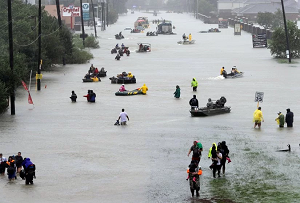 Friday night (the 25th of August) a tropical storm hit Texas in the United States of America. 60cm of rain fell overnight (23 inches) with a total of 50 inches expected before the week was out. Whether or not Texas’ drainage system is able to deal with the volume of water that climate change is bringing will be a pertinent question once relief efforts have been fulfilled. Questions surrounding Houston’s water infrastructure are already being asked.
Friday night (the 25th of August) a tropical storm hit Texas in the United States of America. 60cm of rain fell overnight (23 inches) with a total of 50 inches expected before the week was out. Whether or not Texas’ drainage system is able to deal with the volume of water that climate change is bringing will be a pertinent question once relief efforts have been fulfilled. Questions surrounding Houston’s water infrastructure are already being asked.
A New York Times opinionista has pointed to climate change as the leading cause for Hurricane Harvey’s wrath whilst accusations of America’s hand in contributing to global warming persist. Simultaneously many face practical considerations - what to do in the aftermath of an infrastructure-crippling hurricane.
The devastation caused by Hurricane Harvey will encourage engineers to lend their minds to climate science studies and funnel this knowledge into solutions for a world facing an increase in natural disasters, many of which involve flooding. The lack of engineering foresight, thus far, has been highlighted in neighboring state Louisiana.
No lessons learned
In New Orleans, Lousiana, critical water infrastructure (pumps and canals) were not prepared for heavy rainfall this hurricane season. This is despite the New Orleans’ levee failures in 2005, during Hurricane Katrina. Those levee shortfalls can be found in case studies comparing them to some of the largest engineering failures of all time - including Chernobyl. Furthermore, the studies pertaining to Katrina clearly highlighted the inadequacies of the civil engineering practices within the United States Army Corps of Engineers.
New Orleans experienced a spate of floods on August 5th of this year, with Louisiana’s governor declaring a state of emergency as a result of the flooding. According to the New Orleans Advocate, repairs and maintenance on pumping stations reduced their efficiency by a third!
To give a little clarity to the problem: the drainage system in New Orleans is designed to deal with one inch of rain in an hour, and a half an inch each hour after the first. With this in mind, and according to the Economist, four out of five turbines were not working at one of the state’s pump stations during the floods, and other pumps, in harder hit areas, were down for maintenance. Elsewhere, staff shortages led to inefficiencies so pumps were not switched on in a timely manner.
The citizens in flood-hit areas of New Orleans have accused the sewerage and water board, (amidst other allegations of incompetence) of uncleaned/cleared catch basins which prevented water from moving to the drainage systems. This latest event has led to a political crisis in New Orleans. Officials, however, have said that old and poorly maintained infrastructure is an America-wide problem.
Thankfully New Orleans seems to have escaped the worst of Hurricane Harvey, avoiding the full brunt of the catastrophe 12 years after Hurricane Katrina.
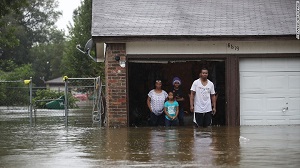
Texas
The rising waters in Houston have resulted in a double-explosion at a chemical plant and, at the time of publishing, the hurricane has led to the deaths of 50 people.
The chemical plant belonged to Arkema Group, one of the world’s largest chemical companies. The coolant systems and power generators were rendered useless due to the floodwaters, and as a result the Arkema Group warned that an explosion was soon to follow. The plant exploded sending a large black plume of smoke into the air and forced police to evacuate an area of up to 1.5 miles. The Environmental Protection Agency (EPA) said that no toxic materials were reported to have been released but will continue to monitor the situation as more explosions are possible.
In Beaumont, Texas, flooding has caused the city’s water pumps to fail, causing 118,000 people to be without any running water. Hospitals have had to evacuate their patients and transfer them elsewhere due to the lack of water.
The Atlantic reports that the Association of State Floodplain Managers in Houston has tried to get funding for flood control, but in vain. Without engineering expertise in storm water management technologies it is unsurprising that an event such as Hurricane Harvey has wreaked such havoc.
City planning has also copped some criticism. An excerpt from the Atlantic’s article points to the fact that Houston and New Orleans’ cities are in flood-prone areas:
“The hardest part of managing urban flooding is reconciling it with Americans’ insistence that they can and should be able to live, work, and play anywhere. Waterborne transit was a key driver of urban development, and it’s inevitable that cities have grown where flooding is prevalent.”
And it seems that Houston’s everyday citizens knew that a hurricane would inevitably cause a flood.
People outside of HOUSTON believe this is a ONETIME thing but this HAPPENS every 2 MONTHS or SO .. BAD ENGINEERING & FLOOD CONTROL pic.twitter.com/oRaX8x7IWg
— Aristotle Onassis (@OnassisHa36) August 28, 2017
This is gonna be fun... But we have to appreciate the City of #Houston Public Works and Engineering team. Or else this would be much worse. pic.twitter.com/YKow0yrKxy
— TheGreatNike (@XboxNike) August 27, 2017
Works Cited
Bogost, Ian. "Houston's Flood Is a Design Problem." The Atlantic. Atlantic Media Company, 28 Aug. 2017. Web. 31 Aug. 2017.
Leonhardt, David. "Harvey, the Storm That Humans Helped Cause." The New York Times. The New York Times, 29 Aug. 2017. Web. 31 Aug. 2017.
In memoriam: Roy Lunn - Automotive Engineering Extraordinaire
It must be one of the most rewarding industries in engineering. Many aspiring engineers in their youth dream of achieving a career in the industry. It entails an amalgamation of engineering disciplines coming together in the design and manufacture of a roaring, road-eating machine.
Automotive engineering incorporates mechanical, electrical, electronic, software and safety engineering. It has given rise to the hobbyists, the racing professionals, and the businessmen. And the industry has just lost one of its stars.

Image: The iconic Ford GT40
Credit: Top Gear
Roy Lunn is one of Ford’s most celebrated engineers. He passed away on the 5th of August 2017 at the age of 92. Originally from Britain, he started his career by obtaining degrees in mechanical and aeronautical engineering at Kingston Technical College, where after he became a pilot in the Royal Air Force. At the end of World War 2, he began his career in automotive engineering. He took his hobby of racing sports cars and made it his career. And what a career it was.
Roy worked for AC Cars in 1946, moved to Aston Martin and worked there from 1947- 49 (where he got his first taste for the Le Mans race) and then moved over to Jowett Cars. In 1953, he joined Ford of England. He was an engineer and product-planning manager for the Ford Motor Company in the United States by 1958. He worked in a department known as the Ford Advanced Concepts Group.

Automotive Hall of Fame Inductee
Roy Lunn was inducted into the Automotive Hall of Fame in 2016. It was on the 50th anniversary of Ford Motor Company’s 1-2-3 finish at the 1966 iteration of the 24 Hours Le Mans race. Roy worked on the GT40 project that led to the undoing of Ferrari’s dominance in the Le Mans race. Ford went on to win the Le Mans race four more times after ‘66.
He didn’t stop there. Lunn contributed to Ford’s most iconic, most recognizable car, The Mustang. Lunn worked on the design team that engineered the 1970 BOSS 429 Mustang. He had had a hand in the design of the Mustang many years before that as well.
He also worked on the presidential limousine for President Nixon and used his engineering background in turbines to produce a gas-turbine-powered 18-wheeler long-distance vehicle, named ‘Big Red’.
Later on in his career, he slowed down a little, but led teams that would manufacture consumer cars. In 1983 he led a team at American Motors Corporation that birthed the Jeep Cherokee. Lunn became the technical director of Jeep and paved the way for the SUVs we know today. Under Roy Lunn, the automotive world saw the first unibody, four-wheel-drive SUV.
For his work on that Cherokee Lunn is today considered the forefather (and ‘Godfather’), of the SUV. The car went on to sell 3 million units, and according to Autoweek, was the first American-branded vehicle to outsource its manufacturing to China.
The future
Towards the end of his life, Lunn began driving a Toyota Prius in a bid to embrace the future of automotive engineering. He also dreamed of contributing to the future of sustainable and clean automotive engineering. According to the New York Times, Lunn began developing a three-wheeled electric vehicle, built out of completely sustainable materials and costing $5,000.
 In 2008, Lunn published a book, ‘Globalization - A Worldwide Quest for A Sustainable Future’. Showing that he truly cared for the earth’s future.
In 2008, Lunn published a book, ‘Globalization - A Worldwide Quest for A Sustainable Future’. Showing that he truly cared for the earth’s future.
Connecting the dots of Roy Lunn’s impact on automotive engineering reveals how influential his presence was to the industry throughout his life. And as automotive engineers endeavor to follow in the footsteps of inspiring Roy Lunn, his influence will stretch into the future too.
Works Cited
"'Godfather of the Ford GT40' Roy Lunn: 1925-2017." Autoweek. Web. 23 Aug. 2017.
"Roy Lunn, Pioneering Engineer of Celebrated Cars, Dies at 92." The New York Times. The New York Times, 18 Aug. 2017. Web. 23 Aug. 2017.
Dear colleagues
When you are on a fixed salary in a company life is pretty certain. But in the more fraught world of consultant and contractor, life can be considerably more complex and financially tricky when dealing with contracts that require you to deliver a specific outcome. Remember if you don’t handle these correctly, you will end up considerably poorer despite putting in an enormous amount of hours working. So it is worth re-considering the different options here as discussed below.
In a simplistic way, as a contractor, you can bid for work in three ways.
Fixed price contracts. These arrangements lock you into a price. Generally, come hell or high water, whatever happens, this is the price you as the consultant or contractor get paid for delivering a specific outcome.
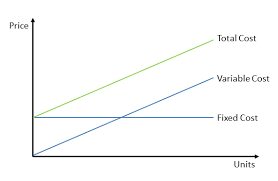
Time and materials. You get paid for both your hours spent on the job as well as the materials supplied to the client.
Two phase contract. In the first phase, you get paid on a time-and-materials basis to define the job to both yours and the client’s satisfaction and then in the second phase you actually perform the contract on a fixed price (or sometimes time and materials basis).
Fixed price can be a gamble
If you know exactly what has to be done and how long it will take and the project is actually achievable (many aren’t – particularly in software development – and I have been there a few times); then this is a great option. But if the outcomes are uncertain and the project is badly defined, you are playing with fire going for a fixed price contract. Sadly enough, many clients know exactly how difficult and risky a particular job will be and go for a fixed price and “lure” a contractor or consultant in to do the job so that the risk is removed from their lives. They are simply after a rock bottom price.
Interestingly enough on the other side of the coin, I see that many contractors go for fixed price contracts knowing full well that they will be able to “drive a bus through the contract” when it comes to negotiating at the end of the job exactly what they will get paid. We had a particularly tough case recently here with an underground tunneling contract which was fixed price (no matter what the consistency of the earth and rock was); but the contractor actually ended up getting compensated for his risk as she incurred substantial additional costs. The client wasn’t too enthused with the thought of lengthy litigation and inability to use the tunnel for an extended length of time so after jumping around for a while, paid up.
If you are forced into going for a fixed price contract and the definition of the job is still a bit uncertain, then ensure that you define exactly what you are going to provide in the contract in terms of hours and materials and some rate of compensation for when the project specifications change. You may find that if you do this precisely enough, you will end up making more money from the variations to the contract than the actual main part of the contract ! A popular strategy followed by some control system vendors who bid a very low fixed price (and thus won the job against fierce competition) with the full knowledge that the variations would compensate them handsomely. If you as the client take on these fixed prices jobs; you will have to spend an inordinate amount of time defining all the terms and conditions and contemplating all eventualities otherwise you are up for considerably more money than originally anticipated.
Sometimes fixed price contracts don’t work too well in odd ways. On one particularly acrimonious job we were advising the client on (for building a Gas Turbine power station); we defined everything extraordinarily clearly and ended up with a fixed price job. Unfortunately the contractor didn’t factor in the risk for writing the control system software and the client had an awkward choice at the end. Either let the contractor go bankrupt and not finish the power station construction or pay more money for the unexpected variations the contractor hadn’t factored in (and thus keep him in business). The client ended up paying well above the fixed price but despite this, after a few months the contractor still went bust. Resulting in the client having to complete the job with the attendant risk now shifted onto her.
Theoretically, you can claim on variations to the contract, but this is always fraught with some negotiation and angst as the client is not overly enthused with paying more. However just remember, when a variation to the contract comes up, at the earliest possible opportunity, you should bring this to the client’s attention and bill him. No matter how awkward and unpleasant this is. If you delay until the end of the contract, you will run the risk of not getting paid.
And at worse case, as a contractor / consultant if you cannot see your way for getting paid for the additional work you are doing, and can’t get agreement from the client for the unreasonable variations that are being imposed on you, simply “up stumps” (as we say in cricketing lore) and leave site. It generally never gets better. It is best to face up to the reality of the situation and avoid your losses getting considerably worse. At this point, you may find that the client can see that you are serious and is more accommodating
Sometimes it helps to compromise
Clients naturally worry that with time-and-materials contracts that they will be “taken to the cleaners” as far as the ultimate price of the job. And this is a well deserved concern. I think often unproven contractors can get lazy and simply bill for every hour. Naturally this is a short term win; as they are unlikely to be invited back on site again.
I would suggest if both client and contractor are unsure that a two phase approach is always the best. Develop and agree on a good specification where the unknowns are clarified and defined for the first phase. And then a fixed price or well considered time-and-materials proposal can be agreed on for the second phase. Let’s face it. At the end of the day, in the specialized world of engineering, it is important that we build up long term trusting relationships between client and contractor and both parties get a fair return on their investment. Not too much. But not too little. But just right.
New Fangled approaches
I worry sometimes about these new fangled approaches of alliances and partnerships between clients and contractors, rather than using fixed price or hourly rates. A bit like a partnership between God and the Devil. With superb management on both sides, they can work out. But often they end up costing one of the parties far more.
And naturally remember that unless you are an altruistic person, that it is better to not get awarded a contract if you are going to lose money on it. Finally, as Samuel Goldwyn wryly remarked: “A verbal contract isn't worth the paper it's written on”. Make sure all agreements are in writing, signed by the correct parties and can cope with project modifications.
Yours in engineering learning
Steve
Mackay’s Musings – 29th August’17 #667
125, 273 readers – www.idc-online.com/blogs/
Engineering mothers save lives with a simple vehicle tool
Elsa Foley, an engineer at Nissan and mother of two boys, has developed an innovative new technology called Rear Door Alert. The inspiration behind this? Every summer, children die from being left inside a hot car. With the help of Marlene Mendoza, another female engineer, Rear Door Alert has been engineered to set off a unique alarm when something has been left behind in the back seat of the car. Take a look at the video below for an explanation of this new innovative technology.
Apple posts secret job listing
On a hidden website, Apple posted a secret job advertisement in a bid to attract the world’s best engineering talents...
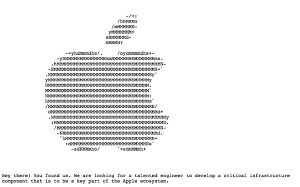
Image courtesy of telegraph.co.uk
However, the initiative backfired when a clever journalist discovered the secret ad. Zac Whittaker, a security reporter with ZDNet, stumbled upon the website whilst analysing data sent from iPhone applications. After Whittaker posted about it on Twitter, the job ad was taken down by Apple.
Futuristic public transport designed by Russian engineering company
Russian engineering company Dahir Insaat has revealed a bizarre plan for what the future of public transport could look like. A gyroscope could be used to avoid traffic entirely, simply by travelling over the top of them. For an animation of how it works, check out the below video.
Although Dahir Insaat’s designs could be deemed as far too futuristic, it is still an interesting idea – and who knows, it could come to life in the future!
Would you live in a floating house in Amsterdam?
With recent advancements in civil engineering, floating homes have become a reality in the bustling city of Amsterdam. Built to protect from the city’s floods, as well as create more space for residential areas, the houses are put together on land and transported to the water via boat.

Image: Amsterdam's "floating village"
Half of the house is underwater, with the structure built from lightweight timber frames. Since the project began in 2011, approximately 20,000 people have moved into these homes. The project will continue on to see a total of 18,000 homes for 45,000 residents, with more of a "village" feel to be created with the future construction of floating schools, restaurants and shops too!
However, although a great solution to floods, unfortunately earthquakes are a major threat to these floating “villages”.
Works cited
The Huffington Post UK. 14 Aug 2017. http://www.huffingtonpost.com.au/2017/08/14/an-engineer-has-reimagined-public-transport-and-it-looks-insane_a_23077583/
Jessica Miley. 20 Aug 2017. http://interestingengineering.com/apple-is-looking-for-talented-engineer-with-secret-job-listing/
Laura Begley Bloom.21 Aug 17.https://www.forbes.com/sites/laurabegleybloom/2017/08/21/this-female-auto-engineer-is-saving-lives-with-one-simple-tool/#4b457968761f
Maarej K. 25 Aug 2017. http://wonderfulengineering.com/floating-houses-are-the-new-thing-in-amsterdam/
Members of our EIT team attended the SkillsWest Expo this last weekend to show off our course offerings.
Our EIT stand showcased a clever robotic arm which visitors were invited to test and drive. We then put everyone’s names into a draw to win one of these mechanical arms - in kit form. We have now drawn a winner and are happy to announce that it is Toby Wallace from Busselton, Western Australia.
We thought that you may like to learn a little about our winner. Toby is in year 11 at school and has a career in engineering firmly in his sights. I think when you have read his story, you will agree that this young man will contribute ably to society and will strive hard to achieve his dreams. This is his story:
I have always been interested in machines and vehicles, most likely due to the fact that I grew up watching star wars, star trek, and playing video games about designing vehicles and using cool technology. When considering what career I would like to pursue, I realised that mechatronics, electronics and mechanical engineering would allow me to be one of the people who gets to build the awesome machines and robots of the future. I have always wanted to build something like an Ironman suit, and I realised that this is the industry that would allow me to do cool things like that.
As technology grows into the future, there is the potential for us to use it for good, but the potential to use it for evil is a major issue. I hope that working in this field will allow me to create devices for help and safety, rather than harm. I would love to work in designing devices for security, and to protect people when they undertake dangerous tasks.
I think it is most likely that I will end up working in a city, as there are very few opportunities for work in the country; however, I think country towns like Busselton will always be on my mind, and I would like to focus on developing devices for them too. One example of this is shark repulsion devices that would save many lives surfing in places such as the Margaret-river region.
Two major things have helped me get an idea of what I want to study. Firstly, I realised that it is possible to work in an industry shown in the movies I loved and in the video games I played; I realised that these weren't just fun, they were job opportunities. Secondly I realised that it is possible to study in many areas, you don't have to limit yourself to one very specific area. I'm planning to do some kind of mechatronics or electronics engineering, but also would like to do audio engineering, as music making is another of my passions. I also realised that some of the other areas I didn't want to miss out on, such as caring for endangered animals, could be done as part time volunteer work while I study and afterwards.
When Toby receives the kit for the robotic arm he will have some building to do, but then it is after all a good part of engineering – engineers create and build cool things. And hopefully he will have a heap of fun in the process.
We wish you everything of the best Toby. And thanks to all the Expo visitors – it was lovely to meet you.
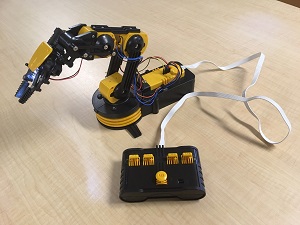

The United States has just witnessed the first total solar eclipse in 38 years. For some US states people would have observed a partial eclipse, but for 14 other states, the moon would have blotted out the sun completely. 2 minutes and 38 seconds of darkness was experienced in Madras, Oregon.
The next total eclipse will appear in American skies on April 8, 2024.
The power grid effect
An obvious impact of a solar eclipse is on photovoltaic cells that rely on the sun’s rays to generate power.
Steven Greenlee from CAISO - one of the largest independent grid operators in the world –commented, “Our solar plants are going to lose over half of their ability to generate electricity during the two to two and a half hours that the eclipse will be impacting our area,”
It is unlike a cloudy day because with an eclipse the loss causes a rapid decline and rebound of solar power that grid operators have to carefully manage.

The U.S. Energy Information Administration (EIA) explained that 70 percent or more of the sunlight for utility-scale solar power plants would be obscured during the solar eclipse.
Source: EIA
It has taken grid managers a year to prepare for the three hours of obscured sunlight. A startling fact when one considers that solar power only makes up 1 percent of the overall US power supply.
Another interesting fact: wind power cannot take up the slack during an eclipse and the drop in solar power because wind drops off too wind slackens during a solar eclipse as well.
Scientists and engineers have used the solar eclipse as a tool for research - keeping an eye on how technology reacts to an event that disrupts both space weather and weather itself.
Chasing an eclipse with engineering
Teachers and students in STEM-related classrooms in schools and universities across the United States ensured that they were ready for the solar eclipse; for example pinhole projectors were built to allow for the safe viewing of the event.
NASA took the eclipse very seriously, ensuring it was scrupulously tracked.
Utilizing specially engineered telescopes mounted to the front of two retrofitted WB-57F aircraft, NASA tracked the shadow of the moon as it shifted across the United States. The aircraft’s telescopes would also capture the Sun’s outer atmosphere (the Corona) during the solar eclipse and also took thermal images of Mercury. The sun’s atmosphere is usually harder to study without a solar eclipse, so it was a valuable moment in time.
The planes climbed to 50,000 feet, progressing through most of the Earth’s atmosphere to obtain the best images possible. Eleven other land-based investigations of the Sun’s atmosphere took place during the solar eclipse too.
Dan Seaton, a co-investigator of the project and researcher at the University of Colorado in Boulder, Colorado, believes the high altitude observations will be more advantageous than those from the ground. He spoke to NASA saying:
“These could well turn out to be the best ever observations of high frequency in the corona. Extending the observing time and going to very high altitude might allow us to see a few events or track waves that would be essentially invisible in just two minutes of observation from the ground.”
This quote that follows is anonymous, but reflects on most all of us during the light of day. Throughout the eclipse, however - just as with the night – most were perfectly still:
“Every morning in Africa, a Gazelle wakes up. It knows it must run faster than the fastest lion or it will be killed. Every morning a Lion wakes up. It knows it must outrun the slowest Gazelle or it will starve to death. It doesn't matter whether you are a Lion or a Gazelle; when the sun comes up, you'd better be running.”
Works Cited
DiChristopher, Tom. "The Total Solar Eclipse Is Going to Knock out a Lot of Solar Power." CNBC. CNBC, 21 Aug. 2017. Web. 21 Aug. 2017.
Garner, Rob. "Chasing the Total Solar Eclipse from NASA's WB-57F Jets." NASA. NASA, 25 July 2017. Web. 21 Aug. 2017.
Choi, Annette. “Solar eclipse 2017: how the solar power industry is prepping for a huge blip” VOX, 20 Aug 2017.Web 24 Aug 2017.
Dear Colleagues
I bumped into an engineering friend the other day – unfortunately he has been out of work for a number of months and is in his late fifties. He was becoming somewhat despondent about the employment situation and at his age it is undoubtedly tough. Employers are very cautious about employing engineering ‘veterans’ no matter how good they are. Unless the employers have a specific need for the specialised skill that you may have.
My take on it is that if you are idling without work; you have to work every angle you can lay your hands on to get back into employment. The longer you are out of the workforce; the harder it is to get back in.
Statistically, it is said that up to 80% of new jobs are never advertised. So what you see on the job’s website and in the newspapers are only a poor shadow of the real activity going on below the surface. Similarly, new projects and work, is often not advertised but given to existing contacts or those who the company knows about.
Unadvertised jobs include jobs that only are created when the right candidate with the right fit of skills (and attitude) comes along. Or there is an impending vacancy that will happen some time in the future and the job is thus not advertised. Or, the hiring manager, is casting around internally for someone suitable; and hasn’t got to the stage of formally advertising.
It is thus not routine practice for employers to screen resumes from strangers to find an appropriate candidate. Employers are extraordinarily risk averse these days – they are looking for a solid referral from a trusted individual who can vouch for the ability of the candidate. Sadly, the old adage is true:’It’s not what you know that matters, but who you know.’
I often hear of job candidates applying for a job, being interviewed and then never hearing anything further. They find out later that some internal candidate has then been appointed to the job (or some “mate of a mate”).
A few suggestions on getting your profile out there and enhancing your chances of securing a good job.
• Keep actively involved on all the various social networking sites especially LinkedIn (very good for professional activities) and their various job and project forums.
• Stay active and involved with your local engineering society and keep vigorously networking and attending presentations by experts
• Join forums which discuss technical topics in your area of interest. Contribute actively.
• Keep talking to all your peers in industry about current developments
• Scan newspapers, magazines and web sites for projects starting up and completing
• Keep an eye on people being employed (as advertised in New Appointments)
• And when looking at job adverts – look not only for jobs but details of new projects/services being created by companies.
• Form relationships with employers – esp. if you are turned down for a job and stay in touch for other opportunities.
• Keep talking to your chums in industry by grabbing a quick cup of coffee with them.
Good luck.
Thanks to Debra Feldman and the IEEE for an excellent article.
And remember – no matter how much you already know, as George Santayana remarks so sagely: The wisest mind has something yet to learn.

Yours in engineering learning
Steve
Mackay’s Musings – 22nd August’17 #666
125, 273 readers – www.idc-online.com/blogs/

Hadi Harb is a qualified Engineer, research scientist, consultant, and business owner. He lends his invaluable knowledge to the Engineering Institute of Technology as a lecturer too. His typical subjects are Programming (C++), Process Control, and sometimes he covers modules relating to data communication, and to anything involving data analysis and signal analysis. He also lectures on topics which touch on research and practice, and practical project management.
Originating from Lebanon, Hadi now lives in Barcelona with his wife and two daughters and enjoys a challenging work life. Apart from lecturing EIT student cohorts based around the world, he consults to a tech company in Japan on artificial intelligence and also runs a family business.
But how and where did Hadi start his journey in the engineering world? And how did he get the itch to forge his specific path forward in engineering?
School, university and beyond
“As a young boy I always liked math and physics. When I got to university, I really had no choice but engineering. Dealing with more technical aspects - it was natural to me,” Hadi recalls. “My school was in Lebanon in a city called Baalbek, an old Roman city. I was there until I was 18, then I went to the capital of Lebanon, Beirut, to study engineering for five years, equivalent to a Masters in engineering. The first three years there you study general engineering. After that, I specialized as an electrical electronics engineer.”
However, whilst Hadi was studying, he came to a fork in the road - he wasn’t sure what career steps to take next. Then he saw a television program where engineers were talking to a robot, and the robot was talking back. That was his ‘aha moment’, Hadi explains.
“So I decided that my final year project would be to control a robot using my voice. I built everything, and it worked, it really worked. It opened opportunities for me to continue my education in France,” he reflects.
He went on to do his Masters and PhD in computer science and was blown away by the capacity of computers. He became particularly interested in artificial intelligence. His focus was on classifying sound signals and detecting the gender of a speaker and the mood of a speaker with artificial intelligence as well.
Entrepreneurship
After finishing his PhD, Hadi worked for a year as a research engineer. He worked with teams whose goal was to classify music signals. Detecting if two songs are similar or not is referred to as ‘music and audio classification’. Basically genre specific music is cross-referenced with other genres and songs in an effort to find similarities with the source music.

“I co-founded a startup called Ghanni. It was about selling technology related to music, similar to the app Shazam. It was really early for this kind of technology so didn’t work extremely well, but it worked. We had some clients - some radio stations used our technology to provide smart radio services to their listeners. The business remained good and acceptable.”
But then Hadi experienced a devastating blow, to the company and personally. One of his colleagues died of cancer. As a result Hadi decided to dissolve the business. “It was sad, really. He was a great guy; 25 years old, he was working on his PhD, but died three years later. And since the business was struggling, I decided to reorganize and go to Barcelona,” he laments.
Reorganization
Hadi went back to basics in order to continue growing his career. He concentrated on the technical aspects of engineering and began to do consultancy in artificial intelligence. One of the companies he consults to is a Japanese company working on intelligent chatbots, similar to Amazon’s Alexa.
At a similar time he joined the Engineering Institute of Technology where he is involved in the education of their students in engineering. He says, “I am trying to share some of my experiences from the past as an engineer, as a research scientist, and as a business owner. I believe there are interesting things to share.”
Resilient entrepreneurial flair
Amazingly there is more: Hadi, together with his family, run Harb Farms in Lebanon. They create and supply several types of cheeses within the country. When asked, “Why cheese?” He explained that the agricultural region he and his family are from inspired their decision to set up a cheese making business. But he did add that they love cheese, “especially Mozzarella!”
Naturally it is interesting to wonder if his engineering background has assisted him with the family business. He believes it has had a significant impact. It allowed him to better organize the cheese making process, all the way from milk production through to the manufacturing of the cheese. He also felt that his research background helped him set up the early R & D and subsequently to improve traditional cheese recipes and adapt them to the market.
We at the Engineering Institute of Technology are very grateful to have Hadi Harb – an educator, entrepreneur and highly qualified engineer - sharing some of his hard wrought experience and knowledge with our students. And obviously we thank Hadi for allowing us to share a little of his life - a successful engineering life.
Engineers have IQ mastered, but do they have emotional intelligence (EQ)?
An engineer takes to a popular engineering online forum and writes: “I can’t get a job because I’m too awkward. Has anybody else been turned down for a job because they lack people skills and/or emotional intelligence?”
The big question is: Do engineers need well developed EQs? The answer is a resounding ‘yes’. As the forum writer above points out: the need for it begins with the interview. Then there are engineers in the workplace completing projects in teams, negotiating with clients etc – all of which requires some emotional intelligence.

Emotional Quotient or Emotional Intelligence (EQ or EI) are terms created by two researchers in 1995 – Peter Salavoy and John Mayer. Psychologist and behavior science journalist, Dr. Daniël Goleman, then introduced the concept to the public and popularized it in 1996 with his book simply called “Emotional Intelligence”.
Goleman was merely using a pithy phrase for what was already known as the ability to recognize, understand and manage our human emotions. The definition has grown to include the understanding and influencing of others. This aspect of EQ would be familiar to engineering managers; and they would understand the inherent difficulties involved.
The blunt truth is that engineers who struggle with EQ may indeed hinder their career growth potential. According to Talent Smart, people with higher EQ make an average of $29,000 more per year than people with low EQ. Not only is EQ good for career success, but it can dictate success when it comes to entrepreneurial endeavor too.
Can it be taught?
Corporate Training International has summarized the kinds of skills people need to hone in order to function efficiently in the corporate world:
- Self awareness
- Self regulation
- Self motivation
- Empathy
EQ is a big help when it comes to making and sustaining relationships in the work place. In an engineering sense, working together efficiently and all being ‘on the same page’ are elements crucial to a synergetic workforce.
There are steps that we can take to contribute to our own well being and to the well being of a workplace. Conflicts, for example, can threaten the equilibrium within a team if handled without emotional intelligence. The following may be useful when attempting to establish a healthier EQ:
- Form new habits
- Care about others’ feelings
- Keep your emotions in check
- Integrate yourself into others’ lives sensitively.
- Take and accept criticism
- Learn from your mistakes

Happiness
The Dean of Engineering at the Engineering Institute of Technology, Steve Mackay, reckons that engineers must be happy in their workspaces, but understands that work pressures can dampen an engineer’s enthusiasm. Mackay calls it the Rule of Two Thirds for Happiness - and thinks engineers should live by the rules and re-evaluate according to the rules every week.
- Are you satisfied with your job?
- Are you comfortable with where you live?
- Do your have fulfilling relationships?
If you can manage two of those three, you should count yourself happy, says the Dean. And, interestingly, happiness is the best environment for a maturing emotional intelligence. A depressed, clouded mind is less likely to make a contribution at work whereas an engineer who has reasons to be positive will become more emotionally astute and resilient and consequently, more productive at work.
Thanks very much to Henlie Holm who inspired and contributed to this article.
Other works cited:
Wallace, Brian. "Emotional Intelligence Is Necessary for You, in Any Field; Here Is Why." Business Standard. Business-Standard, 18 July 2017. Web. 07 Aug. 2017.
CORPORATE TRAINING. 2017. Emotional Intelligence - Training material for trainers. www.corporatetrainingmaterials.com Date of access: 23 June 2017.
Dear Colleagues
As you all know – common sense is NOT so common around here when it comes to avoiding industrial failures. Often these failures are caused by avoidable (always) strategies such as good maintenance, better quality equipment and better training for staff.
Historically, a hundred years ago a telegraph problem could have disrupted a few people’s lives – however the scale today of the impact of an electrical failure (power or communications) can be huge.
Some examples of these spectacular failures (as listed in the IEEE Your Engineering Heritage: The $25 Million Ceiling Fan and the £100 Million Server by Robert Colburn) are quite laughable but were hugely painful to all involved:
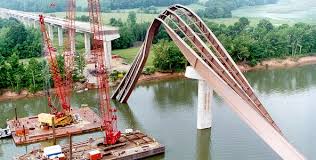
British Airways
The most recent failure which you may remember was the British Airways fiasco which probably cost the airline of the order of $120m involving a damaged computer server (and perhaps some inadequate training in remedying the problem). This caused the cancellation of all flights from two UK airports for a day causing massive irritation for stranded passengers (it was a holiday).
Newark Airport New Jersey
In January 1995, a construction crew damaged a 26kV cable (using steel piles so it was conclusively damaged) for the entire airport. Emergency generators weren’t sufficient. 70% of the flights had to be cancelled. There was a chink of a solution – two back up powercables – but they ran through the same conduit which had been damaged.So no cigar here either.
Smoke Shuts Down Airport
A few years ago, a tiny (cheap) extractor fan in a bathroom started smoking resulting in the evacuation of the entire O’Hare airport facility. A huge 800 flights were cancelled.Over reaction, perhaps.
Crashing the European Powergrid
A small drop in power to de-energise the powerline across the Ems River in Germany to allow a cruise liner to pass underneath resulted in blackouts across Europe from Poland to Morocco.Mainly because all the power supplies were on a knife edge.
Solar Storms
With the growing intensity of electrical transmission power lines throughout the world (particularly in North America and Europe), solar storms have created strange power power drop outs and impacted on delicate electronic equipment such as radar (again used for passenger flights).
What Should One Do about Preventing these Failures ?
It is always easy in retrospect to give solutions to these problems. What are good strategies to deal with these rather troubling issues ?
First of all – don’t go for the cheapest solution no matter how silly the purchase may appear. It may be a critical element in a chain of items.
Think carefully about safety and back up systems. Consider failure points of the entire system carefully.You may find something trivial could be the cause of massive failure.
Ensure staff are trained to handle typical maintenance issues and also the grand swag of unexpected contingencies with common sense and a proactive approach.
Thanks to Robert Colburn of the IEEE History Center at the Stevens Institute of Technology in Hoboken, N.J. USA.
A fabulous comment to bear in mind from William Gibson (Zero History): When you want to know how things really work, study them when they're coming apart.
Yours in engineering learning
Steve
Mackay’s Musings – 15th August’17 #665
125, 273 readers – www.idc-online.com/blogs/
We are happy to announce that our 4 Bachelor of Science programs have been approved for on-campus delivery. Students are now able to apply for an International Student Visa to study at our Perth, Western Australian campus.
The Engineering Institute of Technology (EIT) is the only college dedicated to the fields of engineering and technology, and ultimately to your success in learning
Our campus is in Perth, the sunny and friendly capital city of Western Australia, and we would like to invite you to study here with us.
We are very proud to offer you one of our four Bachelor of Science degrees in engineering. They cover the important disciplines of Mechanical, Civil and Structural, Industrial Automation and Electrical. And for those students who have already graduated with a Bachelor degree we have the Master of Engineering (Industrial Automation) - a growing and vital field of work in the world today.
Our programs are inspired by industry because they are designed and presented by an international cohort of experienced engineers. We continuously improve our content to ensure it remains on the cutting-edge of engineering endeavour. And to further prepare you for the workplace and enhance your learning experience we have a dynamic and modern approach to the practical components of the programs.
Western Australia is an exciting state for the practice of engineering because it is rich in resources, has a growing renewable energy focus, a vast range of agriculture, investment in infrastructure and is engaged in varied and robust automation projects.
Perth itself is a beautiful and clean city without being overly crowded. The beaches are magnificent and everyone, both the locals and visitors, love the weather.
For cricket enthusiasts, our EIT campus in East Perth is on the doorstep of the WACA and also a few steps away from the free city busses.
If you are looking for an adventure overseas and a world class qualification in engineering please contact us at
A pedestrian bridge on the N3 road in Bedfordview, in Johannesburg collapsed in the early hours of the morning on Tuesday the 8th of August 2017. The bridge collapsed onto four vehicles, resulting in five injuries with zero fatalities.
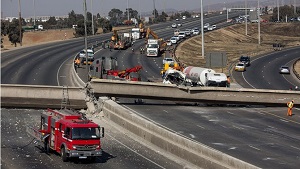
The highway has been re-opened since the collapse. Transport Minister Joe Maswanganyi finds the collapse odd, saying the bridge was deemed safe in 2016. He said: “Sanral did an inspection of the bridge and we were told that the bridge was in a good condition and we have a certificate in that regard. What happened on Wednesday was shocking.”
The bridge was built in 1978. It was recently decommissioned and thus regarded as an abandoned bridge but still thought to be rigid enough to stay standing.
The transport minister has tasked forensic experts and officials from the Council for Geoscience and Sanral (South African National Roads Agency) with investigating what caused the bridge’s collapse.
Rubble removal teams spent the public holiday on Wednesday removing the collapsed bridge to allow traffic to flow.
Speculation
Whilst the investigation progresses armchair critics are offering possible causes for the bridge’s demise. Some of these assessments point to another disaster which occurred at a similar time: an earth tremor apparently triggered by the collapse of an illegal mine. The reports of this illegal mine caving in are unverified, but could certainly account for the accident if proved true.
Dr Eldridge Kgaswane, scientist for the Council for Geoscience was, however, skeptical. He pointed out that there had indeed been a tremor, but because it only measured 2.0 on the Richter scale was an unlikely cause. He suggested that a tremor measuring around 6.0 would have been a more likely catalyst for the bridge’s collapse.
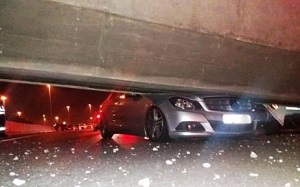
Talking to IOL (a South African news website), a ward councilor Gill Humphreys says that vandalism could have been the cause. She pointed out the bridge had been tampered with for years, “Over this time, it has been stripped of nuts and bolts and all steel reinforcing. We are questioning why Sanral did nothing to ensure the safety of the bridge, as this almost certainly caused the collapse.”
Questions have also been asked about a truck bumping into it at some point and whether this had compromised the structural quality of the bridge.
Another more outlandish online allegation is that a bomb caused the pedestrian bridge to fall. At the time of publishing, however, none of these rumors have been confirmed.
The validity of infrastructure inspections has been questioned following the collapse. Engineers now tirelessly work to end the speculation. SANRAL delivered a statement reading:
“We are relieved that we managed to clear the debris and open the road in less than 48 hours. We wish to thank the teams involved in the collaborative effort to clear the site. At the same time, we have not forgotten those who were injured during the bridge collapse. We wish them a speedy recovery and are keeping them in our prayers.”
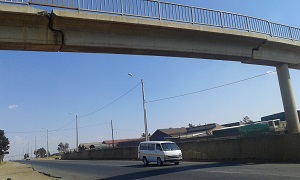
Avoiding future collapses
Twitter users are warning that more bridge collapses could occur in South Africa. They believe their age is one of the factors compromising their structural integrity. This photograph of a pedestrian bridge at the R61 next to Angus Station in Ekurhuleni clearly shows signs of structural disintegration.
They are asking for their photos to be retweeted in an effort to motivate their municipal governments to do something about these aging bridges.
A probe into what caused a bridge scaffolding collapse back in 2015 on Grayston Drive in Johannesburg is still ongoing. The bridge collapse caused the death of two and injured 19. What remains apparent is that South African civil and structural engineering entities need to take bridge construction, assessment and maintenance more seriously in years to come to avoid potential catastrophic failures.
Works Cited
Cox, Anna. "Industry News." Vandalism May Have Led to Bridge Fail | IOL Motoring. 10 Aug. 2017. Web. 10 Aug. 2017.
"Johannesburg N3 Bridge Collapse: Traffic Flow Restored, but Questions Remain over Inspections." Daily Maverick. Web. 11 Aug. 2017.
In an effort to partner with universities, with the IET (one of the world’s largest multidisciplinary engineering bodies) and with other educational entities in the engineering space, Steve Mackay visited the UK on a whirlwind trip this month.
There is much chatter about the online, digital age of learning and as we know Steve is not only passionate about the opportunities that this platform of learning offers to students, but is a staunch proponent. He is poignantly aware that there are students in parts of the world who are unable to either reach a campus or access world-class education for any number of reasons, some of which include financial and geographical constraints and full time work.
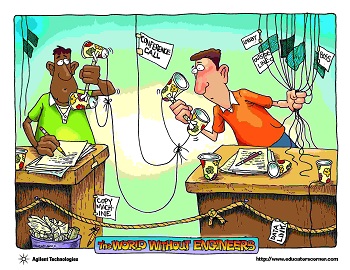
During this visit to the UK he certainly witnessed a shift in attitude towards distance learning and, to varying degrees, implementation progress. The favoured approach seems to entail a more sophisticated version of the old asynchronous style of online teaching. Traditional readings are now meshed with videos, automated quizzes and forms of gamification.
Cambridge University, whose lecture theatres remain brimming with the student elite from around the world, is even considering the implications of an online model. Steve was heartened to see the glimmer of interest in a number of their dynamic engineering dons. The idea of sharing their quite remarkable academic prowess and their vast research and industry capability with those who cannot make it to Cambridge was not lost on them.
Among others Manchester University is bravely promoting a new online Master of Science in Electrical Power Systems and Liverpool University and their partners are well and truly forging ahead with online course options, mainly in IT.
Steve believes that EIT can learn much from these UK entities, but with its own robust synchronous online learning platform and considerable volume of cutting-edge engineering content, he also firmly believes that EIT can offer a great deal in return. Steve, together with the EIT team, will redouble their efforts to ensure these partnerships benefit and ultimately improve the educational outcomes and opportunities for those drawn to engineering and technology in all corners of the globe.
Thanks to http://www.bornmobile.co.il/index.php?q=node/148 for the amusing image.
Dear Colleagues
As you all know, the global workforce is rapidly growing. And it is rapidly becoming more multicultural and multinational. We all have our own cultures, skills, behaviours and attitudes about life and work which are generally focussed on our local environment or town. However companies are increasingly straddling borders or are required to work with suppliers/clients and partners in different countries. Fortunately for some of us, the English language is becoming the key language used; but cultures and attitudes don’t line up that that easily.
I marvel at the different cultures and languages around the world and would hate to see everything crushed into one uniform Macdonalds type culture.
A few suggestions follow in boosting your positive interaction with your engineering colleagues in different countries with different cultures.
A researcher, Ms Tsedal Neeley, reckons there are five attributes you require to successfully work in this new environment. These are:
Delight in Positive Indifference
Ignore cultural differences that may impact on you. In fact, consider them irrelevant and a non-event.
Look for Common Features in Different Cultures
When working with people from different cultures look for examples of similarities. For example, you may find both Japanese and American cultures embrace efficiency and productivity. Whereas Indian and Italian love good food and style.
When Thinking of your Multinational Company focus on the Global Company rather than individual offices.
Look at the values and goals of the global company rather than local nuances and issues.
Actively seek out Interaction with Other Cultures in Distant offices.
The trick is to welcome interactions and to thrive on them especially when they are totally different cultures. Consider them enriching you. This heightened level of interaction does tend to build trust and improve mutual understanding of how each party works.
Aim for Your Global Engineering Career rather than a Local One.
Working as an expat used to be unusual. Today, one should aspire to working in different countries as part of a global engineering career.
Thanks to a lovely article written by Tsedal Neeley entitled: How to Successfully Work Across Countries, Languages, and Cultures
In support of this, the famous car manufacturer CEO, Carlos Ghosn, remarked: More and more, in any company, managers are dealing with different cultures. Companies are going global, but the teams are being divided and scattered all over the planet.
Yours in engineering learning
Steve
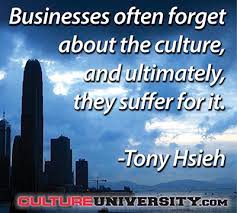
Mackay’s Musings – 8th August’17 #664
125, 273 readers – www.idc-online.com/blogs/
There are more than enough photographs of abandoned buildings on the internet to fill tome, but the history behind them is often overlooked. Oftentimes abandoned buildings speak of a troublesome past - a past where engineers, among others, were involved in constructing the next great thing which did not stand the test of time for various reasons. Engineers from a subsequent generation are then employed to take the abandoned husk of past infrastructure, and turn it into something new.
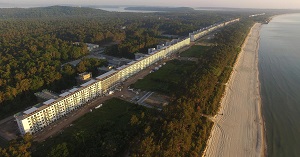
Abandoned buildings are, however, most often demolished; it is rare for them to be re-purposed for the arrival of new tenants. Despite this, the coastline of Rügen in Germany is experiencing just such a renewal. A seaside resort in Rügen, once belonging to the Nazi Party, is now being re-upholstered and turned into the sort of holiday destination Adolf Hitler could only have dreamed of.
German engineering
The original construction began in 1936. The entire resort stretched along the edge of the coast for an impressive 4.5 kilometers. Engineers were tasked to construct 8 identical buildings, each 450 meters in length, and build them to accommodate 20,000 inhabitants. The plans to make it into a fully functioning resort were halted when war began in 1939.
The buildings were built out of reinforced concrete, a very new and ‘cutting edge’ method of structural engineering at the time. (Proof that German engineering was churning along and innovating even in the 1930s.) 9,000 laborers were used to construct the eight blocks. A cinema and a theater were built as well.
Historian and tour guide Roger Moorhouse told Business Insider:
“The photos cannot physically do it justice. By all accounts, it would have been one of the most impressive structures in the world.”
It was purportedly built for the industrial workers of Nazi Germany, a resort for much needed holidays. Historians, however, believe it was also used for the indoctrination of German people and this more sinister reputation remains.
It was built as part of a Nazi expansion project known as Strength Through Joy. The most notable engineering endeavor that came out of this expansion project was the Volkswagen Beetle.
Constant re-purposing
The 8 buildings in Rügen underwent further changes after World War 2. The Soviets destroyed one of the buildings, but before that they occupied one of them as a military barracks from 1945 to 1955. Some buildings were then rebuilt, renovated and restored in 1990.
In 1993, the entire area, with exception to Block 3, was deserted after being used by military schools and political asylum seekers. Block 3, between 1995 and 2005, was used as an exhibition and museum area to educate people about the past. After 2004, after not being able to find permanent residents for the blocks, the resort was opened up to private investors.

Renovated Praro Resort
Credit: Business Insider
From 2006 onward, ownership of the blocks changed hands several times, but by 2013 the Praro Resort had emerged. The four buildings that remained standing were renovated into a hotel and re-purposed into elderly housing. Tennis courts and a swimming pool were added, and a shopping center was built. The project cost north of $131 million. A fifth block was turned into a youth hostel which is now considered to be one of Germany’s largest youth hostels.
A bright future for abandoned buildings?
Could abandoned buildings rise again in the smart city future? With global population growth and the expansion of cities, the demand for infrastructure and housing increases. Civil and structural engineers could find themselves attached to renovation projects like the Prora Resort in the near future; creating something new out of something old and forgotten, giving it new meaning, and being cognizant of the past.
Works Cited
Baranowski, Shelley. "Family Vacation for Workers: The Strength through Joy Resort at Prora | German History | Oxford Academic." OUP Academic. Oxford University Press, 01 Oct. 2007. Web. 24 July 2017.
Weller, Chris. "Hitler's 3-mile-long Abandoned Nazi Resort Is Transforming into a Luxury Getaway." Business Insider. Business Insider, 01 Sept. 2016. Web. 24 July 2017.
The world’s first floating farm off Scotland’s north-east coast
The trial Peterhead wind farm, named Hywind, is estimated to provide power to 20,000 homes, with the turbine output expected to equal or surpass generation from current ones. This breakthrough technology will see wind power being harvested in waters that are too deep for the current conventional bottom-standing turbines.
Below: the wind turbines are currently being put in place. Image credit: BBC.com

Fast facts:
- Each tower weighs 11,500 tonnes
- Turbines can operate in water up to 1km deep
- Each blade measures 75 metres
UK to ban new diesel and petrol vehicles from 2040
In a bid to reduce air pollution, the UK government will put into action a £255 million fund, as well as publishing a court-mandated clean air strategy. This has come after a new order by the courts for the government to act upon the illegal levels of harmful pollutant nitrogen dioxide. To help accommodate such a change, buses and other transport will need to be cleaned, roads may need relayout and road features such as speed humps may need to be added in to smoothen vehicle flow.
Forget planes – fly on a $10 000 drone!
A Swedish man has invented a $10,000 Vertical Take-Off and Landing (VTOL) drone, called the ‘chAIR’, which can lift a person several feet over the ground. The creator, Axel Borg, completed his first successful flight last month. The footage below shows him aboard the drone, navigating through the forest and dodging obstacles without a hitch.
Fukushima: Robot finds what could be melted nuclear fuel
The first images of what could be melted nuclear fuel deposits inside Japan’s Fukushima nuclear plant have been captured by an underwater robot. If the findings are confirmed, it will be a major stepping stone in the clean-up operation (from when the power plant was hit by a tsunami in 2011, forcing over 200,000 people out of their homes). Locating fuel debris in each of the damaged reactors is a crucial part of the decommissioning process, which is expected to take many years.

Image: BBC. Lava-like rocks were found under one of the damaged reactors
The need for speed: Google intends to make the Internet faster
It seems that technology continues to advance at an extraordinary speed, making it difficult for the Internet to keep up. The engineers at Google understand the modern day demand for faster internet, and are therefore looking for alternate solutions. The BBR (Bottleneck Bandwidth and Round-trip propagation time) is a congestion and control algorithm that plays a large role in internet speed. If Google’s engineers can incorporate this algorithm into the system, internet speed could increase and ultimately reduce the minor inconveniences and annoyances of a slow Internet connection.
Works Cited
Harrabin, Roger. “World's first floating wind farm emerges off coast of Scotland.” 23 Jul 2017. BBC.com. http://www.bbc.com/news/business-40699979
Harrabin, Roger. New diesel and petrol vehicles to be banned from 2040 in UK. 26 Jul 2017. BBC.com. http://www.bbc.com/news/uk-40723581
Gohd, Chelsea. “Google Wants to Make the Internet Faster. Here’s How.” 24 July 2017. Futurism.com. https://futurism.com/google-wants-to-make-the-internet-faster-heres-how/
BBC News. “Fukushima disaster: Robot finds possible melted nuclear fuel”. 23 July 2017. BBC.com. http://www.bbc.com/news/world-asia-40696303
Sohail, Umer. “Swedish Man Creates A $10,000 Drone That Can Carry A Man”. WonderfulEngineering.com. 20 Aug 2017. http://wonderfulengineering.com/swedish-flying-carpet-drone-carries-man/.
 We have all heard of the common engineering jobs such as Electrical Engineer, Civil Engineer, Mechanical Engineer and Software Engineer; let’s take a look at some of the uncommon and perhaps ‘cool’ engineering jobs that actually do exist.
We have all heard of the common engineering jobs such as Electrical Engineer, Civil Engineer, Mechanical Engineer and Software Engineer; let’s take a look at some of the uncommon and perhaps ‘cool’ engineering jobs that actually do exist.
Dear Colleagues
In the past few years; we have seen some spectacular collapses of buildings and bridges. This is quite inexplicable to today’s structural designer and engineer who puts enormous effort into the careful use of materials and huge safety margins. In addition, it is not only about care in design but also in putting into place monitoring mechanisms for the life of the structure.
However, when a designer is operating at the limit of their expertise; mistakes still occur. One of the questions with the Deepwater Horizon oil rig which exploded with massive damage was in the use of cement (coupled with nitrogen gas) a few kms under the seabed – as to whether it did indeed have the strength required to prevent a massive gas and oil surge. As we know, cement as a proven structural material has been around since Roman times – but for perhaps more predictable environments.
The typical approach a structural engineer follows when assessing materials for safe use and which would give some background to the building you live in, is as follows.
Lab Testing
All materials used are extensively lab tested to determine their structural properties such as tension and compression under loading. The design strength actually used is considerably lower than these figures.
Design Strength Varies Depending on Materials
The calculation of design strength varies from concrete and steel which are fairly predictable and of uniform quality to wood which is rather varied. Wood is considerably more variable in strength as it could have an unusual number of knots or come from a diseased tree. Thus the safety margin has to be considerably higher.
For example, the Douglas fir, has a safety margin of 5.5 (versus 1.4 for Steel). For example, Douglas fir has a compression maximum strength of 51 MPa (7430 psi) and based on the safety margin of 5.5; a design strength of 9.3MPa (1350 psi).
However, (as we know from the Twin Towers disaster) steel can have problems for structural support. As you may recall it is weak in fires and must be protected in all buildings.
Additional Safety Margins
Structural engineers build in additional safety margins by overestimating the dead and live loads and selecting supports one size up from what the design suggests.
Beware when you are at the Limits of Technology
However, despite all this care; you have to be careful about operating at the limits of technology and as to whether you will see sudden loads well in excess of what you designed (DeepWater Horizon) or indeed, your materials exposed to conditions they were never designed for (Twin Towers).

Try and Anticipate What Happens in the Future
In Africa recently, there have been a few spectacular bridge collapses where it would appear that the corrosion of the reinforcing structures were a cause of a weakening of the structure. Coupled with theft of reinforcing steel. The last is hard to understand but this is what was reported.
In essence, what I am saying is that even with considerable planning and design expertise taking into account the relevant safety margins, all structures should be monitored throughout their lives. With today’s technology and of course internet connectivity, this is surely achievable without too much expense.
Thanks to 101 Things I learned in Engineering School by John Kuprenas with Matthew Frederick.
Andrew Heller makes an interesting point: Technology is like a fish. The longer it stays on the shelf, the less desirable it becomes.
Yours in engineering learning
Steve
Mackay’s Musings – 25th July’17 #662
125, 273 readers – www.idc-online.com/blogs/
What can house 1,000 passengers, a boatload of cargo, and 850 vehicles? You guessed it. A ferry.
The UK Government’s Department of Transport in their 2016 Provisional Sea Transport Report stated that the number of international short sea passengers was estimated at 20.0 million people in that year. Norway also utilizes ferries in a big way. Until the completion of the first underwater tube-shaped floating tunnel, the only way to navigate Norway’s fjords is via ferries.
With that many people utilizing the form of transport, it is in the best interest of the engineering companies that run them to regularly perform maintenance on the ships. Extending the lifetime of a ferry is a three week slog, that guarantees the ferry another ten years of operation.
A little South of Norway, a battalion of ferries operate in the North Sea, enabling transport between a number of countries including the United Kingdom, France, Germany and Belgium. One of the ferries that should be up for its next maintenance operation in 2022 is the Pride of Bruges. The ferry consists of 32,000 tonnes of steel, 7 football field sized decks, with 4 engines which burn two and a half thousand litres of fuel an hour. It was renovated in 2012.
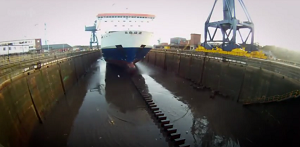
Exterior
The operation involving exterior and interior maintenance takes an army to complete. The Newcastle engineering team consists of 120 engineers who work on the boat, examining over 1,000 separate parts.
The most critical parts of the ferries which require attention are underwater; if it is not docked, the boat cannot be repaired, maintained or renovated.
Thus, the first challenge is getting a mammoth ferry into the ferry lock. The lock is flooded with 133 million litres of water that allows the ferry to be pushed into the lock. After that, the water is emptied out so that the ferry can be accessed and assessed on dry land. Most of the engineering works are below the water line.
Once the hull of the ferry is accessible to the engineers, one of the first things investigated are the ballast tanks. Ballast tanks are compartments within a floating structure which take water in, in order to ensure stable buoyancy. The tanks are emptied and cleaned so that the overhauling of them can begin. Corrosion proofing ensues within the inner steelworks.
When the ferry is functional, water is pumped in and out of the ballast tanks, based on the buoyancy required. Engineers explain that saltwater and freshwater have different buoyancies. There is a measurement ruler on the side of the boat that suggests water levels for the different buoyancies.

Another crucial element of the ferry that must be checked, over and above everything else, are the retractable fins, known as stabilizers. They keep the boat from rocking back and forth and giving the crew sea sickness. Actuators ensure that they are perfectly synchronized on either side of the ship.
The most common of all ferry maintenance is performed on the steel boat itself. Seawater corrodes the steel, thus it needs to be constantly weather proofed to avoid rust and wear. To avoid seawater from eroding to the point of catastrophic failure sacrificial anodes are fitted to the hull - they take the brunt of the seawater damage so that the steel beneath it doesn’t corrode as quickly.
The ship’s two propellers are also polished. They are closely studied to detect cracks and other surface imperfections; fractures must be fixed. Propellers suffer from what is known as cavitation erosion. This occurs because of the implosion of water bubbles around the propellers during the ship’s operation. It has the ability to render propellers useless. Thus, polishing them ensures a longer lifetime.
Finally, rudders are checked to ensure that the boat can be maneuverered back into the sea. Controlled by hydraulic actuators, the rudders are controlled by the captain housed inside the bridge.
Interior
Aside from maintenance to the exterior, the complex technological systems responsible for, among other critical jobs, steering the ship, require trouble shooting and checking. These computers are vital to the smooth running of a ferry.
Global positioning systems are also being installed in ferries to make sure that captains are aware of exactly where they are going and to monitor other boats that are filling up shipping lanes.
Further inside the ship, the replacing of steel floors occur where the car deck is positioned. Wear and tear of the steel flooring occurs due to the tonnes of cars that weigh the steel down during its lifetime. A new layer of steel is placed atop the old one.

Image of the boat traffic between the English Channel.
In the engine room, refurbished barrel-sized pistons are positioned to fire away once the ferry is ready for action again. The pistons cost £15,000 per piston. 30 pistons are required for a ferry the size of the Pride of Bruges.
These are just some of the engineering challenges involved when maintaining ferries. On completion they are carefully moved from their locks back into the ocean. After their three weeks in dry dock they should remain in good shape for another decade. These maintenance visits keeps the teams of repairers on their toes; delays are extraordinarily costly.
Works Cited
"Engineering Giants - 3. Ferry Strip-Down." BBC IPlayer. BBC. Web. 10 July 2017
Are you willing to travel internationally for work and study?
This is a loaded question. A range of considerations would be pondered and include family, need for excitement, ambition, prospects etc.
Few academic qualifications have the global allure that engineering does. And some engineers are characterized by their determination to acquire those credentials which enable them to take on the world.
Most people, however, are more content to remain in their communities, to study, work and raise their families within the familiarity of ‘home’. And then there are those that might develop a thirst for travel and work, but are unsure how to start; how to make their qualifications mobile, how to look for opportunities that could take them elsewhere.

An occupation in high demand in Australia for example, is engineering and they have recently amended their temporary and skilled visa occupations list. Engineers looking to work on another continent, therefore, should note such changes to policy.
For work experience abroad, specifically in Australia, there are two options for qualified engineers.
Option 1: The Skilled Recognised Graduate Visa
If a qualified engineer is under 31 years of age he or she can apply for the Skilled Recognised Graduate Visa. If, after getting a taste for it, the engineer would like to settle in Australia, an application to do so can be made.
Interestingly, the Australian government does not require previous work experience from those engineers who want to apply for this visa. Spouses and dependent children can go too.
Option 2: Skilled Independent Visa
Engineers over the age of 31 are able to apply to immigrate to Australia, with their spouses and children. In fact qualified engineers are on the Medium and Long-term Strategic Skills List (MLTSSL) that the Australian government has set out. At times the Australian government has been known to recruit from overseas if certain skill sets are required.
There is nothing quite like engineering when it comes to being a vital contributor to the infrastructure of a country. Engineers have the necessary skills to keep a country running. It is when gaps in these skills are perceived that governments actively recruit from overseas.
Immigration Minister of Australia, Peter Dutton, has indicated that their recent policy changes are a reflection of the ‘genuine skill needs in the labor market’.
Check your eligibility here: LIST OF ELIGIBLE SKILLS OCCUPATIONS
Another reason to travel abroad is for study
For a student to study overseas he or she must be accepted by an education institution, one that has been registered to accept international students.
In Australia the registering body is the Commonwealth Register of Institutions and Courses for Overseas Students (CRICOS). It is responsible for ensuring their education facilities and courses are up to scratch.
 Australia is a popular study destination and this has made its study centres richly diverse, with people from all over the globe acquiring qualifications.
Australia is a popular study destination and this has made its study centres richly diverse, with people from all over the globe acquiring qualifications.
Studying overseas is appealing for a number of reasons. It provides students with the prospect of living in and experiencing a new environment for a number of years. It may also provide the students with learning opportunities that cannot be attained in their own countries. And it offers them the chance to work in other parts of the world.
For engineers who have a taste for travel the importance of obtaining globally recognized skills cannot be underestimated. It provides those, with this wanderlust, the opportunity to form part of a global engineering company that takes them around the world.
Works Cited
"Lists of Eligible Skilled Occupations." Department of Immigration and Border Protection. Web. 12 July 2017.
"Move to Australia." Move to Australia | Personal Consultations. Web. 12 July 2017.
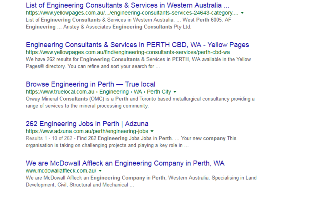 It is often difficult for engineers to position themselves into the search engines result pages (SERP's) because of the very competitive nature of the industry. It is dominated by the worlds major companies and the smaller more regional firms often find themselves on the back pages.
It is often difficult for engineers to position themselves into the search engines result pages (SERP's) because of the very competitive nature of the industry. It is dominated by the worlds major companies and the smaller more regional firms often find themselves on the back pages.
It is therefore vitally important that you do a SWOT analysis, that is, an internal study of your strengths and weaknesses as well as your opportunities and threats.
Once you understand yourself, have a look at your direct competitors, not just in your area of expertise but also similar firms in different regions. Look for where they rank, how the pages are laid out and what type of content they use.
Content is critical.
Do not try to impress with language that only a 10 year industry expert can understand. Remember, those looking to engage you are not necessarily the decision makers, it may be an executive assistant, secretary or office junior.
Have photos and a brief profile description of the owners and principles of your company, I would not put up all your employees as your competitors will probably try to poach them (you may have a couple of under-performers, so it may be a good thing).
The same goes for successful projects that you have completed, a few photos and a brief description of what you have done, once again, keep the language simple, and don't give away your key contacts/clients, your competitors are always looking for work.
Don’t be afraid to place your “job opportunities” on your website with an application lodgement form. If you don’t currently have any open positions, you will be amazed at who "appears" in your inbox. Economically it makes sense, I know of one firm who saved over $200K in recruitment fees in 6 months.
Make sure that you are not "too" broad in your descriptions of what you do, try to create a "point of difference". Have you ever noticed how well a "spelling mistake" ranks?
- Use bullet points - Bullet points help with the readability of your content and allow for a fast intake of content.
- Use relevant headings - This helps with the readability and allows readers to skim to the specific areas that interest them.
- Use relevant images - Stay away from stock images, some projects will not allow photos without permission.
Once you have got your content sorted, the rest is relatively simple.
- Page load speed - Ensure your site loads quickly on all devises and in all regions.
- Mobile friendly - The uptake of mobile visitors is well over 60% of web traffic, have a look at your site on your phone.
- Phone number - Top right hand corner of the page with a hyperlink to phone.
- Contact form - Name, Phone, Email, you do not need to know what they had for breakfast.
On completion of the above, the readability and usability of your site will be far better than average.
Having original relevant articles, written consistently, and posted on your site, maintains a freshness that the search engines want to see. (These articles can be used in your newsletters.)
Good, honest, fresh, relevant content with a site that loads quickly on multiple devices in multiple regions will ensure that you will improve your rankings. Why? because your competitors don't do it.
More in a couple of weeks
Dear Colleagues
As an old pal of mine, once remarked about his career: ‘Find out what you enjoy doing which adds value to other peoples’ lives and never ever work again’. What he was saying is that if you can do something at work which gives you meaning to your life and which you truly enjoy; you really have a great job which is the same as your hobby.

Corporations Spend Millions
Corporations spend millions of dollars on trying to motivate their staff and give them meaning to their work. One only needs to think of hospitals instilling the need to be caring about other people and a well known car company who promotes safety. However, this spirit of meaning, tends to disappear when engaged in the daily grind of work.
There is no doubt that if you feel there is an inner purpose to your job and you feel very satisfied in it that you will stick around it a lot longer and really strive to add value to what you do everyday.
Certainly, I would find it difficult working on a daily basis underground in a dangerous coal mine to find any inner purpose in what I do every day besides keeping myself healthy and extracting lots of money for my daily work. Perhaps, an inner purpose or meaning doesn’t apply to certain jobs.
How do you identify your inner purpose at work ?
A few questions to ask yourself and your colleagues in establishing a inner purpose to a job:
What do you really enjoy doing ? What do you look forward to doing at home or at work ? What gets you energised, passionate and enthusiastic about being engaged in ? What would you eliminate from your job and what would you emphasise and add to make it even more enjoyable?
What do you excel at ? What tasks do you do extraordinarily well at ? What do people sit up nd notice about you and always comment at how well you do it ?
Where do you feel that you add value and contribute to the organisation ?
Who do you enjoy working with and who do you create superb synergies with ?
Examples
Some examples of colleagues who tell me that they have meaningful jobs
Glenn is an engineer who thrives on working in plant design and optimising tough areas with significant problems. He believes his inner purpose is to build plants which are trouble free, highly efficient, safe and run forever.
Rodney is an accomplished instructor and loves teaching process instrumentation and control. He believes his inner purpose is to upskill others so that they can be more valuable in their careers and enjoy themselves more.
Remember as T.F. Hodge says: ‘Day or night, good or bad…all things from within.’
Thanks to Kristi Hedges who wrote the very interesting: 5 Questions to Help Your Employees Find Their Inner Purpose at the Harvard Business Review.
Yours in engineering learning
Steve
Mackay’s Musings – 18th July’17 #661
125, 273 readers – www.idc-online.com/blogs/
The Rio-Antirrio Bridge is a modern engineering marvel that, at its heart, relies on engineering expertise and lessons from the past. Opened in August 2004, the bridge wowed engineers because it reflects and marks the progress of bridge building through history. The bridge is one of the longest multi-span, cable-stayed, suspension bridges in the world.

Credit: By Eusebius, CC BY-SA 3.0, https://en.wikipedia.org/w/index.php?curid=39009078
The bridge links the Peloponnese peninsula to mainland Greece. These landmasses have moved further and further away from each other over hundreds of years, subsequently creating what is known as the Gulf of Corinth. The 2 mile gap was not the only unique challenge the Gulf of Corinth presented to engineers. The other challenges were the strong winds in the middle of the channel, and the fact that the bridge was going to cross one of the largest seismic zones in Europe.
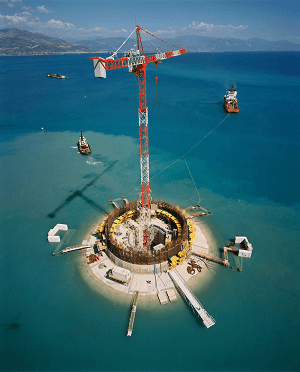
Too much ground to cover
A 2 mile stretch is too wide for a single span bridge; engineers realised they had to develop a multi-span bridge. In the planning stages the depth of the water posed the initial setbacks; the Gulf of Corinth is sixty meters deep.
The answer was to use hollow, concrete, floating barges. This engineering concept was the brainchild of engineer Guy Maunsell, who invented floating forts for the purposes of battle during World War 2. Offshore wind turbine operations use these floating barges and they are commonly employed in modern day bridge building. Between 1998 and 2001, the four hollow pier foundations, needed to construct the Rio-Antirion Bridge, were floated into place.
Avoiding Natural disasters
Instead of burying the foundations in the ground, they were set atop the seabed, which had been reinforced by steel bars and ten feet of gravel. This was to ensure that the bridge could move with the ground during earthquake activity, to reduce the risk of the bridge being damaged by an earthquake. This is now known as seafloor stabilization, but it was a first in engineering bridge building history.
To further avoid the seismic activity’s effect on the bridge’s structure, the engineers implemented jacks and dampers that absorb any earthquake activity. Basically, the bridge has enormous shock absorbers.
Credit: "GEFYRA - Nikos Daniilidis"
Furthermore, the bridge is completely suspended to ensure that earthquakes do not make the bridge sway. It is held in place by 348 cables. The cables are made of single strands of steel grouped together to form one large cable. The steel strands are more flexible and collectively stronger than iron. Previously iron had been used on bridges that had experienced catastrophic failure.
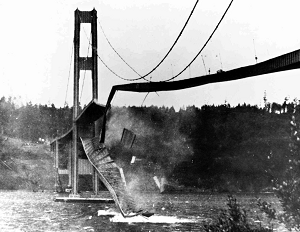
The Tacoma Narrows Bridge. Credit: Seattle Times
To guard against damage from the wind the bridge uses the same aerodynamic wind diffusing fairings and spoilers that you would expect to see on a car, but on a grander scale. The cables are also wrapped with spiral Scruton strakes that allow wind to flow around the cables instead of straight into them.
These civil engineering nuances of bridge building may have saved the Tacoma Narrows Bridge in 1940. It was given the nickname ‘Galloping Gertie’ due to the effects of the winds; its vertical sway caused catastrophic failure. The Tacoma Narrows Bridge disaster serves as a case study and explains why the Rio-Antirrio Bridge used a system of cable-stays and suspension bridge construction technologies instead.
The Rio-Antirrio Bridge is considered a modern masterpiece. The engineers are applauded for their considerations of past bridge failures, and for their ability to come up with solutions to problems that had never before been addressed in the industry. And that is why this bridge is considered a modern engineering marvel.
Works Cited
RION-ANTIRION BRIDGE - An Engineering Marvel - Dr. Carolyn Pararas-Carayannis. Web. 20 June 2017.
Panajotisx. "Rio Antirrio Bridge - Challenging Earthquakes." YouTube. YouTube, 19 Jan. 2014. Web. 20 June 2017.
Dear Colleagues
Ferocious and violent arguments are the part of life in engineering. Needless to say, they are rarely productive. And often very damaging to relationships and self esteem. A few suggestions on breaking an argument in its tracks and focussing on positive productive outcomes follows….
An Argument over Defective Software
I have been involved in many meaningless arguments which have got heated and always regretted the unproductivity of them all. I remember having a vigorous exchange of views on testing control software for a large gas-fired power station. The project manager didn’t believe a black start was necessary to test the software in its entirety as he felt it (the software) was fine in the preliminary tests. I didn’t trust the software and wanted to do a thorough and meticulous test under real world conditions.
This resulted in such an acrimonious exchange between me and the project manager that we forgot to pay the bill for the café we were arguing in. Much to our huge embarrassment. This cooled the argument down dramatically once the waitress accused us of avoiding payment for our meal. Fortunately, I won the argument and we did test the software and it was confirmed that it was catastrophically defective. However we could have got there without a huge argument – something which damaged our professional relationship for many months.
Productive Conflict is Good
Personally, I believe productive conflict is a good thing. In any business, you don’t want everyone agreeing and ‘walking into the sunset together’. It is vital that everyone has a strong professionally-based viewpoint and we then iterate to the best solution. However, the process in arriving at this best solution can often result in an acrimonious argument.
What often happens is that in the haste to respond to someone, no reference is made to what the other person has said. Instead, you simply jump to your position and ignore all mention of what the other person has said. You often see this when a politician is being interviewed - possibly in a confrontational way. Rather than answer a specific question or respond to a specific point, the politician simply jumps to what they want to say. (Which is often of no relevance to the topic under consideration at all).
Once this process starts, it simply cascades into a violent quick interchange of views. And it is rarely productive. Often it descends to personal attacks or slights on the other party’s team. Body language can play a significant role where you turn your back on the offending person and face those who support you.
The Trick
I believe the trick to defuse this situation is to acknowledge what the other person has said -but in a positive way. And to focus unerringly on the problem under consideration by restating it clearly and simply again. This can be hugely painful for you but it does start defusing the argument very quickly as the other person would be surprised and perhaps, even pleased that you are taking their point into account.
I have found on occasion that the process of restating the problem takes most of the heat out of the argument as all parties often didn’t quite understand what it was. And were too keen to get at each other throats. We also didn’t have a moment to consider the other person’s position.
Occasionally, I have found someone has a malicious intent and are being deliberately argumentative. This is however rare. Your sincerity and enthusiasm for transparency and an open solution can often win this person over. Esp. if they are surrounded by others who want to do the right thing.

Suggestions Suggestions on Quickly Resolving the Argument….
Emphasise that you want to hear the other perspectives to an argument, you value everyone’s input and you want to focus on the issues in arriving at the best outcome.
Emphasise this again and again to re-assure everyone else. Always repeat what the other parties have said to confirm your understanding of what this position is.
Dig deep down into yourself and ensure that you also agree with the requirement to come up with the best outcome – meaning that your particular argument actually may not be the best and you may have to accommodate someone else’s suggestion. This realization is ofen very painful. But there is no point in winning an argument and then to come up with a poor solution. Everyone loses in this situation.
Also try and use lateral thinking to come up with innovative approaches that may resolve the argument and be acceptable to everyone - but more importantly – represent the optimum solution to the problem.
Good language to use
Some phrases you may use in defusing an acrimonious exchange:
‘This is a vital issue and I welcome all points of view.
We are looking for the best solution.
We need to focus on the issues…
That was a brave/innovative/gutsy/clever suggestion.
We need to all think differently in coming up with solutions – that is how we arrive at the best solution.’
And then….
‘I respect the other points of view but I am not enthusiastic about this approach because this is my thinking on the issue…..I welcome your perspective on what I have said as we focus on the best solution.’
The Best Will Out
If you focus on the best outcomes and keep transparent and open in your discussions, you can surely avoid an acrimonious exchange and build partnerships and bridges with your peers.
Watch out though that you don’t all start thinking the same way with no differences and end up with ‘Group Think’ (everyone mindlessly agreeing and taking a hazardous decision as a result) situations…which is perhaps even worse than having an acrimonious argument as it could result in dangerous outcomes.
Thanks to Liane Davey who wrote an interesting article in HBR entitled: When an Argument Gets Too Heated, Here’s What to Say. I have adapted it to engineering professionals.
An ancient poet, Rumi wrote: ‘Raise your words, not your voice. It is rain that grows flowers, not thunder.’
Yours in engineering learning
Steve
Mackay’s Musings – 11th July’17 #660
125, 273 readers – www.idc-online.com/blogs/
Blog - Steve Mackay
EIT's Technical Director, Steve Mackay, enjoys keeping his blog up-to-date with useful tips and current industry matters for his fellow colleagues. He has a loyal and expanding following base reaching over 300,000 people around the world.
Student Stories
In this section you have the opportunity to read and listen to EIT students talking about the reality of the programs. Discussions are wide-ranging and include information about the study commitment required, the value of the qualification in their careers, the relevance of the subject matter, future pathways, and more. They provide valuable feedback for you to take into account before you decide to join one of our programs.
Career Information
Latest career information including industry research, podcasts, blogs, life hacks and general information about how you can make the most out of your career.
Education
Here you will find out more about the latest trends and developments within education worldwide, along with some helpful articles regarding study tips and keeping on track with your studies.
Developments
The latest innovation and inventions from the world of engineering can be found here. Learn about advances in technology and how they can make a real difference within your industry.
Announcements
Keep up to date with the latest announcements from the Engineering Institute of Technology. In this section you can read more about new courses, new recognition from professional bodies, our Excellence in Teaching Award, upcoming free webinars and much more.
Monthly Update
We understand that you may not have time to read all the articles that we post, so our monthly update gives you access to some fascinating articles which cover the best of the months news in a compact format.


